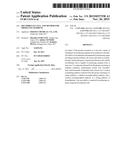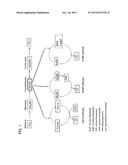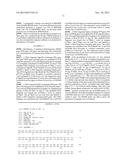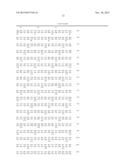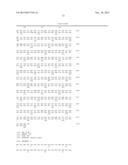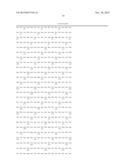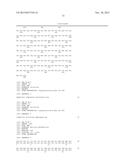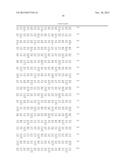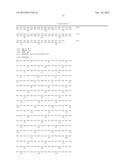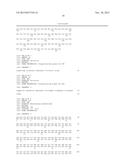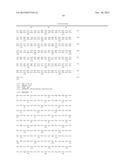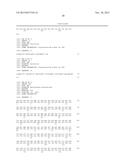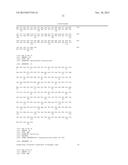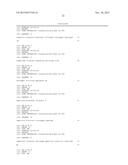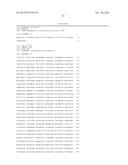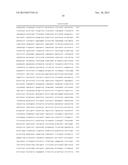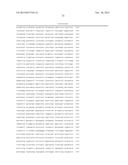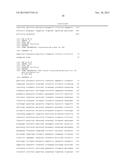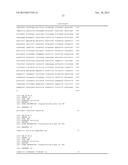Patent application title: RECOMBINANT CELL AND METHOD FOR PRODUCING ISOPRENE
Inventors:
Masahiro Furutani (Arakawa-Ku, Tokyo, JP)
Akihiro Uenishi (Tsukuba-Shi, Ibaraki, JP)
Koichiro Iwasa (Setagaya-Ku, Tokyo, JP)
IPC8 Class: AC12P502FI
USPC Class:
435167
Class name: Micro-organism, tissue cell culture or enzyme using process to synthesize a desired chemical compound or composition preparing hydrocarbon only acyclic
Publication date: 2015-11-26
Patent application number: 20150337338
Abstract:
An object of the present invention is to provide a series of techniques
for producing isoprene from methanol or the like. Provided is a
recombinant cell prepared by introducing a gene encoding isoprene
synthase, into a host cell which is a methylotroph, wherein the gene is
expressed in the host cell, and the recombinant cell is capable of
producing isoprene from at least one C1 compound selected from the group
consisting of methane, methanol, methylamine, formic acid, formaldehyde,
and formamide. Preferably, it has at least one C1 carbon assimilating
pathway selected from the group consisting of a serine pathway, a
ribulose monophosphate pathway, and a xylulose monophosphate pathway as a
fixing pathway of formaldehyde. Also provided is a method for producing
isoprene using the recombinant cell.Claims:
1-39. (canceled)
40. A recombinant cell prepared by introducing a gene encoding isoprene synthase, into a host cell which is methylotroph, wherein the gene is expressed in the host cell, and the recombinant cell is capable of producing isoprene from at least one C 1 compound selected from the group consisting of methane, methanol, methylamine, formic acid, formaldehyde, and formamide.
41. The recombinant cell according to claim 40, having at least one C 1 carbon assimilating pathway selected from the group consisting of a serine pathway, a ribulose monophosphate pathway, and a xylulose monophosphate pathway as a fixing pathway of formaldehyde.
42. The recombinant cell according to claim 40, wherein a gene encoding 3-hexulose-6-phosphate synthase and a gene encoding 6-phospho-3-hexuloisomerase are further introduced, and the genes are expressed in the host cell.
43. The recombinant cell according to claim 40, wherein the host cell has isopentenyl diphosphate synthesis ability by a mevalonate pathway, and wherein a gene encoding at least one enzyme acting in a mevalonate pathway and/or a gene encoding a group of enzymes acting in a non-mevalonate pathway are/is further introduced, and the gene is expressed in the host cell.
44. The recombinant cell according to claim 43, wherein the gene encoding at least one enzyme acting in a mevalonate pathway is derived from actinomycete.
45. The recombinant cell according to claim 40, wherein the host cell has isopentenyl diphosphate synthesis ability by a non-mevalonate pathway, and wherein a gene encoding a group of enzymes acting in a mevalonate pathway and/or a gene encoding at least one enzyme acting in a non-mevalonate pathway are/is further introduced, and the gene is expressed in the host cell.
46. The recombinant cell according to claim 45, wherein the gene encoding at least one enzyme acting in a non-mevalonate pathway is derived from those other than the host cell.
47. The recombinant cell according to claim 40, wherein a gene encoding isopentenyl diphosphate isomerase is further introduced, and the gene is expressed in the host cell.
48. The recombinant cell according to claim 40, wherein a treatment of suppressing an expression amount of geranyl pyrohosphate synthase, neryl pyrophosphate synthase, or farnesyl pyrophosphate synthase is conducted.
49. A recombinant cell prepared by introducing a gene imparting a function of converting methanol and/or formic acid into formaldehyde, a gene imparting formaldehyde fixing ability, and a gene encoding isoprene synthase, into a host cell, wherein the genes are expressed in the host cell, and the recombinant cell is capable of producing isoprene from at least one C1 compound selected from the group consisting of methane, methanol, methylamine, formic acid, formaldehyde, and formamide.
50. The recombinant cell according to claim 49, having at least one C1 carbon assimilating pathway selected from the group consisting of a serine pathway, a ribulose monophosphate pathway, and a xylulose monophosphate pathway as a fixing pathway of formaldehyde.
51. The recombinant cell according to claim 49, wherein the gene imparting a function of converting methanol into formaldehyde is a gene encoding methanol dehydrogenase or alcohol oxydase, and the gene imparting a function of converting formic acid into formaldehyde is a gene encoding formaldehyde dehydrogenase.
52. The recombinant cell according to claim 49, wherein a gene imparting a function of converting methane to methanol is further introduced, and the gene is expressed in the host cell.
53. The recombinant cell according to claim 49, wherein a gene encoding 3-hexulose-6-phosphate synthase and a gene encoding 6-phospho-3-hexuloisomerase are further introduced, and the genes are expressed in the host cell.
54. The recombinant cell according to claim 49, wherein the host cell has isopentenyl diphosphate synthesis ability by a mevalonate pathway, and wherein a gene encoding at least one enzyme acting in a mevalonate pathway and/or a gene encoding a group of enzymes acting in a non-mevalonate pathway are/is further introduced, and the gene is expressed in the host cell.
55. The recombinant cell according to claim 54, wherein the gene encoding at least one enzyme acting in a mevalonate pathway is derived from actinomycete.
56. The recombinant cell according to claim 49, wherein the host cell has isopentenyl diphosphate synthesis ability by a non-mevalonate pathway, and wherein a gene encoding a group of enzymes acting in a mevalonate pathway and/or a gene encoding at least one enzyme acting in a non-mevalonate pathway are/is further introduced, and the gene is expressed in the host cell.
57. The recombinant cell according to claim 56, wherein the gene encoding at least one enzyme acting in a non-mevalonate pathway is derived from those other than the host cell.
58. The recombinant cell according to claim 49, wherein a gene encoding isopentenyl diphosphate isomerase is further introduced, and the gene is expressed in the host cell.
59. The recombinant cell according to claim 49, wherein a treatment of suppressing an expression amount of geranyl pyrohosphate synthase, neryl pyrophosphate synthase, or farnesyl pyrophosphate synthase is conducted.
60. A recombinant cell prepared by introducing a gene imparting a function of converting methanol and/or formic acid into formaldehyde, and a gene encoding isoprene synthase, into a host cell having a ribulose monophosphate pathway, wherein the genes are expressed in the host cell, and the recombinant cell is capable of producing isoprene from at least one C1 compound selected from the group consisting of methane, methanol, methylamine, formic acid, formaldehyde, and formamide.
61. The recombinant cell according to claim 60, wherein the gene imparting a function of converting methanol into formaldehyde is a gene encoding methanol dehydrogenase or alcohol oxydase, and the gene imparting a function of converting formic acid into formaldehyde is a gene encoding formaldehyde dehydrogenase.
62. The recombinant cell according to claim 60, wherein a gene imparting a function of converting methane to methanol is further introduced, and the gene is expressed in the host cell.
63. The recombinant cell according to claim 60, wherein a gene encoding 3-hexulose-6-phosphate synthase and a gene encoding 6-phospho-3-hexuloisomerase are further introduced, and the genes are expressed in the host cell.
64. The recombinant cell according to claim 60, wherein the host cell has isopentenyl diphosphate synthesis ability by a mevalonate pathway, and wherein a gene encoding at least one enzyme acting in a mevalonate pathway and/or a gene encoding a group of enzymes acting in a non-mevalonate pathway are/is further introduced, and the gene is expressed in the host cell.
65. The recombinant cell according to claim 64, wherein the gene encoding at least one enzyme acting in a mevalonate pathway is derived from actinomycete.
66. The recombinant cell according to claim 60, wherein the host cell has isopentenyl diphosphate synthesis ability by a non-mevalonate pathway, and wherein a gene encoding a group of enzymes acting in a mevalonate pathway and/or a gene encoding at least one enzyme acting in a non-mevalonate pathway are/is further introduced, and the gene is expressed in the host cell.
67. The recombinant cell according to claim 66, wherein the gene encoding at least one enzyme acting in a non-mevalonate pathway is derived from those other than the host cell.
68. The recombinant cell according to claim 60, wherein a gene encoding isopentenyl diphosphate isomerase is further introduced, and the gene is expressed in the host cell.
69. The recombinant cell according to claim 60, wherein a treatment of suppressing an expression amount of geranyl pyrohosphate synthase, neryl pyrophosphate synthase, or farnesyl pyrophosphate synthase is conducted.
70. A recombinant cell prepared by introducing a gene imparting a function of converting methanol and/or formic acid to formaldehyde and a gene imparting formaldehyde fixing ability into a host cell having isoprene synthase, wherein the genes are expressed in the host cell, and the recombinant cell is capable of producing isoprene from at least one C1 compound selected from the group consisting of methane, methanol, methylamine, formic acid, formaldehyde, and formamide.
71. The recombinant cell according to claim 70, wherein the gene imparting a function of converting methanol into formaldehyde is a gene encoding methanol dehydrogenase or alcohol oxydase, and the gene imparting a function of converting formic acid into formaldehyde is a gene encoding formaldehyde dehydrogenase.
72. The recombinant cell according to claim 70, wherein a gene imparting a function of converting methane to methanol is further introduced, and the gene is expressed in the host cell.
73. The recombinant cell according to claim 70, having at least one C 1 carbon assimilating pathway selected from the group consisting of a serine pathway, a ribulose monophosphate pathway, and a xylulose monophosphate pathway as an fixing pathway of formaldehyde.
74. The recombinant cell according to claim 70, wherein a gene encoding 3-hexulose-6-phosphate synthase and a gene encoding 6-phospho-3-hexuloisomerase are further introduced, and the genes are expressed in the host cell.
75. The recombinant cell according to claim 70, wherein the host cell has isopentenyl diphosphate synthesis ability by a mevalonate pathway, and wherein a gene encoding at least one enzyme acting in a mevalonate pathway and/or a gene encoding a group of enzymes acting in a non-mevalonate pathway are/is further introduced, and the gene is expressed in the host cell.
76. The recombinant cell according to claim 75, wherein the gene encoding at least one enzyme acting in a mevalonate pathway is derived from actinomycete.
77. The recombinant cell according to claim 70, wherein the host cell has isopentenyl diphosphate synthesis ability by a non-mevalonate pathway, and wherein a gene encoding a group of enzymes acting in a mevalonate pathway and/or a gene encoding at least one enzyme acting in a non-mevalonate pathway are/is further introduced, and the gene is expressed in the host cell.
78. The recombinant cell according to claim 77, wherein the gene encoding at least one enzyme acting in a non-mevalonate pathway is derived from those other than the host cell.
79. The recombinant cell according to claim 70, wherein a gene encoding isoprene synthase is further introduced, and the gene is expressed in the host cell.
80. The recombinant cell according to claim 70, wherein a gene encoding isopentenyl diphosphate isomerase is further introduced, and the gene is expressed in the host cell.
81. The recombinant cell according to claim 70, wherein a treatment of suppressing an expression amount of geranyl pyrohosphate synthase, neryl pyrophosphate synthase, or farnesyl pyrophosphate synthase is conducted.
82. A method for producing isoprene comprising culturing the recombinant cell according to claim 40 by using at least one C1 compound selected from the group consisting of methane, methanol, methylamine, formic acid, formaldehyde, and formamide as a carbon source, to cause the recombinant cell to produce isoprene.
83. A method for producing isoprene comprising culturing the recombinant cell according to claim 49 by using at least one C1 compound selected from the group consisting of methane, methanol, methylamine, formic acid, formaldehyde, and formamide as a carbon source, to cause the recombinant cell to produce isoprene.
84. A method for producing isoprene comprising culturing the recombinant cell according to claim 60 by using at least one C1 compound selected from the group consisting of methane, methanol, methylamine, formic acid, formaldehyde, and formamide as a carbon source, to cause the recombinant cell to produce isoprene.
85. A method for producing isoprene comprising culturing the recombinant cell according to claim 70 by using at least one C1 compound selected from the group consisting of methane, methanol, methylamine, formic acid, formaldehyde, and formamide as a carbon source, to cause the recombinant cell to produce isoprene.
86. A method for producing isoprene comprising bringing at least one C1 compound selected from the group consisting of methane, methanol, methylamine, formic acid, formaldehyde, and formamide into contact with the recombinant cell according to claim 40, to cause the recombinant cell to produce isoprene from the C1 compound.
87. A method for producing isoprene comprising bringing at least one C1 compound selected from the group consisting of methane, methanol, methylamine, formic acid, formaldehyde, and formamide into contact with the recombinant cell according to claim 49, to cause the recombinant cell to produce isoprene from the C1 compound.
88. A method for producing isoprene comprising bringing at least one C1 compound selected from the group consisting of methane, methanol, methylamine, formic acid, formaldehyde, and formamide into contact with the recombinant cell according to claim 60, to cause the recombinant cell to produce isoprene from the C1 compound.
89. A method for producing isoprene comprising bringing at least one C1 compound selected from the group consisting of methane, methanol, methylamine, formic acid, formaldehyde, and formamide into contact with the recombinant cell according to claim 70, to cause the recombinant cell to produce isoprene from the C1 compound.
Description:
TECHNICAL FIELD
[0001] The present invention relates to a recombinant cell capable of producing isoprene from methanol or the like, and a method for producing isoprene using the recombinant cell.
BACKGROUND ART
[0002] Isoprene is a monomer raw material for synthetic polyisoprene, and is an important material, in particular, in the tire industry. In recent years, the technique for conversion from a production process of basic chemicals relying on petroleum to a production process from renewable resources such as plant resources has been developed and practical realization thereof is steadily progressing. Also regarding isoprene, for example, a production technique from saccharides as a raw material by recombinant Escherichia coli is known (Patent Documents 1 and 2, and Non-patent Document 1).
[0003] On the other hand, among C1 compounds, methanol is produced at a low cost from natural gas, synthetic gas which is a mixed gas of carbon monooxide, carbon dioxide and hydrogen obtained from biomass and wastes such as municipal wastes, and so on. Natural gas is focused as a next-generation energy source because it abundantly exists in fossil resources, and generates a relatively small amount of CO2, and transition from conventional petroleum to natural gas is progressing. Methanol is easy to handle and stock because of its water solubility and so on, and is also suited as a carbon source in microbial culture.
[0004] A methylotroph is a general name for a C1 compound assimilating microorganism that uses a carbon compound not having a C--C bond in the molecule, e.g., methane, methanol, methylamine, dimethylamine, trimethylamine or the like as a sole carbon source or energy source. Any microorganisms called methanotroph, methane-oxidizing bacteria, methanol assimilating bacteria, methanol assimilating yeast, methanol assimilating microorganism belong to methylotrophs.
[0005] Central metabolism of methylotroph is a reaction of converting formaldehyde into an organic matter having a C--C bond after converting methanol to formaldehyde. As shown in FIG. 1, as a carbon assimilation metabolism pathway via formaldehyde, a serine pathway, a ribulose monophosphate pathway (RuMP pathway), and a xylulose monophosphate pathway (XuMP pathway) can be recited. Methylotrophs classified into bacteria (methylotrophic bacteria) have a serine pathway or a RuMP pathway. On the other hand, methylotrophs classified into yeast (methylotrophic yeast) has a XuMP pathway.
[0006] Methylotrophic bacteria are classified into obligate methylotrophs and facultative methylotrophs capable of using other carbon compound according to the difference in methanol requirement.
PRIOR ART DOCUMENTS
Patent Document
[0007] Patent Document 1: WO 2009/076676
[0008] Patent Document 2: WO 2009/132220
NON-PATENT DOCUMENT
[0009] Non-patent Document 1: Yang J., et al., PLoSOne 2012, 7(4), e33509
DISCLOSURE OF INVENTION
Technical Problem
[0010] Regarding the production process from renewable resources, most of the conventional techniques including the aforementioned isoprene production technique are production methods by microorganisms relying on organic substances, in particular, saccharides, glycerol or oil components. However, for covering the global production quantity of a large number of basic chemicals derived from petroleum, the amounts of currently available saccharides, glycerin and oil components derived from plant resources and the like will be necessarily insufficient for carbon sources of microorganisms. In other words, the production amounts of basic chemicals by microorganisms relying on saccharides or oil components is limited also in the future. These processes also have a fear of competition with foods.
[0011] Application examples of methylotrophs include production techniques of SCP (single cell protein), biodegradable plastic, amino acid and so on from methanol. However, there has been no case that a methylotroph is applied to production of basic chemicals derived from petroleum such as isoprene. As described above, all of the monomer compounds utilized in general polymer material products rely on petroleum at present, however, the possibility that petroleum having the quality equivalent to that of currently used petroleum is supplied is very low, and development of a new, efficient, alternative process is urgently demanded. Although a technique of saccharifying hard biomass including cellulose, hemicellulose, lignin and the like is examined for the purpose of ensuring carbon sources for production of chemicals by microorganisms, an enzyme treatment for saccharification is required, and a significant problem in terms of the cost arises.
[0012] In light of the above, it is an object of the present invention to provide a series of techniques capable of producing isoprene from methanol or the like.
Solution to Problem
[0013] One aspect of the present invention for solving the aforementioned problem is a recombinant cell prepared by introducing a gene encoding isoprene synthase, into a host cell which is a methylotroph, wherein the gene is expressed in the host cell, and the recombinant cell is capable of producing isoprene from at least one C1 compound selected from the group consisting of methane, methanol, methylamine, formic acid, formaldehyde, and formamide.
[0014] Isoprene synthase has the function of converting dimethylallyl diphosphate (DMAPP) which is an isomer of isopentenyl diphosphate (IPP) into isoprene. Structure conversion between isopentenyl diphosphate and dimethylallyl diphosphate is catalyzed by isopentenyl diphosphate isomerase. Isopentenyl diphosphate isomerase exists in any organism.
[0015] The recombinant cell of the present aspect is prepared by introducing a gene encoding isoprene synthase, into a host cell which is a methylotroph, and the gene is expressed in the host cell. And it is able to produce isoprene from at least one C1 compound selected from the group consisting of methane, methanol, methylamine, formic acid, formaldehyde, and formamide. The recombinant cell of the present aspect is able to convert dimethylallyl diphosphate and isopentenyl diphosphate synthesized in the cell into isoprene by the action of isoprene synthase. That is, according to the recombinant cell of the present aspect, it is possible to produce isoprene from the aforementioned C1 compound.
[0016] Preferably, the recombinant cell has at least one C1 carbon assimilating pathway selected from the group consisting of a serine pathway, a ribulose monophosphate pathway, and a xylulose monophosphate pathway as a fixing pathway of formaldehyde.
[0017] Preferably, a gene encoding 3-hexulose-6-phosphate synthase and a gene encoding 6-phospho-3-hexuloisomerase are further introduced, and the genes are expressed in the host cell.
[0018] With such a configuration, formaldehyde fixing ability by the ribulose monophosphate pathway is imparted or enhanced.
[0019] Preferably, the host cell is bacterium or yeast.
[0020] Preferably, the yeast belongs to genus Pichia, genus Hansenula, or genus Candida.
[0021] Other aspect of the present invention for solving a similar problem is a recombinant cell prepared by introducing a gene imparting the function of converting methanol and/or formic acid into formaldehyde, a gene imparting formaldehyde fixing ability, and a gene encoding isoprene synthase, into a host cell, wherein the genes are expressed in the host cell, and the recombinant cell is capable of producing isoprene from at least one C1 compound selected from the group consisting of methane, methanol, methylamine, formic acid, formaldehyde, and formamide.
[0022] The recombinant cell of the present aspect is prepared by introducing "gene imparting the function of converting methanol and/or formic acid into formaldehyde", "gene imparting formaldehyde fixing ability", and "gene encoding isoprene synthase" into a host cell, and these genes are expressed in the host cell. And it is able to produce isoprene from at least one C1 compound selected from the group consisting of methane, methanol, methylamine, formic acid, formaldehyde, and formamide.
[0023] That is, since the recombinant cell of the present aspect is prepared by introducing "gene imparting the function of converting methanol and/or formic acid into formaldehyde", and "gene imparting formaldehyde fixing ability", it has characteristics similar to those of a methylotroph. And, since "gene encoding isoprene synthase" is introduced, isoprene synthase can be expressed in the cell. As a result, it is possible to convert isopentenyl diphosphate synthesized in the cell into isoprene. That is, also by the recombinant cell of the present aspect, it is possible to produce isoprene from the aforementioned C1 compound.
[0024] Preferably, the recombinant cell has at least one C1 carbon assimilating pathway selected from the group consisting of a serine pathway, a ribulose monophosphate pathway, and a xylulose monophosphate pathway as a fixing pathway of formaldehyde.
[0025] Another aspect of the present invention for solving a similar problem is a recombinant cell prepared by introducing a gene imparting the function of converting methanol and/or formic acid into formaldehyde and a gene encoding isoprene synthase, into a host cell having a ribulose monophosphate pathway, wherein the genes are expressed in the host cell, and the recombinant cell is capable of producing isoprene from at least one C1 compound selected from the group consisting of methane, methanol, methylamine, formic acid, formaldehyde, and formamide.
[0026] The present aspect corresponds to the form wherein, for example, a non-methylotroph having a ribulose monophosphate pathway is a host cell.
[0027] Preferably, the gene imparting the function of converting methanol into formaldehyde is a gene encoding methanol dehydrogenase or alcohol oxydase, and the gene imparting the function of converting formic acid into formaldehyde is a gene encoding formaldehyde dehydrogenase.
[0028] Both of methanol dehydrogenase and alcohol dehydrogenase have the function of converting methanol into formaldehyde. Also, formaldehyde dehydrogenase has the function of converting formic acid into formaldehyde. Any of these enzymes is one of the methane metabolism enzymes in methylotrophs belonging to bacteria. On the other hand, methylotrophs belonging to yeast does not have methane oxidizing activity, but has the function of converting methanol into formaldehyde by the action of alcohol oxydase. Also yeast has the enzymatic activity of converting formic acid into formaldehyde.
[0029] Preferably, a gene imparting the function of converting methane into methanol is further introduced, and the gene is expressed in the host cell.
[0030] Preferably, the gene imparting the function of converting methane into methanol is a gene encoding methane monooxygenase.
[0031] Methane monooxygenase has the function of converting methane into methanol. Also methane monooxygenase is one of methane metabolism enzymes in methylotrophs.
[0032] Preferably, a gene encoding 3-hexulose-6-phosphate synthase and a gene encoding 6-phospho-3-hexuloisomerase are further introduced, and the genes are expressed in the host cell.
[0033] Preferably, the host cell is bacterium or yeast.
[0034] Preferably, the host cell has isopentenyl diphosphate synthesis ability by a mevalonate pathway, and a gene encoding at least one enzyme acting in a mevalonate pathway and/or a gene encoding a group of enzymes acting in a non-mevalonate pathway are/is further introduced, and the gene is expressed in the host cell.
[0035] With such a configuration, synthesis ability of IPP which is a supply source of DMAPP is enhanced, and IPP and DMAPP are efficiently supplied. As a result, the recombinant cell of the present aspect has still higher isoprene productivity.
[0036] Preferably, the gene encoding at least one enzyme acting in a mevalonate pathway is derived from actinomycete.
[0037] Preferably, the host cell has isopentenyl diphosphate synthesis ability by a non-mevalonate pathway, and a gene encoding a group of enzymes acting in a mevalonate pathway and/or a gene encoding at least one enzyme acting in a non-mevalonate pathway are/is further introduced, and the gene is expressed in the host cell.
[0038] With such a configuration, synthesis ability of IPP which is a supply source of DMAPP is enhanced, and IPP and DMAPP are efficiently supplied. As a result, the recombinant cell of the present aspect has still higher isoprene productivity.
[0039] Preferably, the gene encoding at least one enzyme acting in a non-mevalonate pathway is derived from those other than the host cell.
[0040] Preferably, the isoprene synthase is derived from plants.
[0041] Preferably, the gene encoding isoprene synthase encodes a protein of the following (a), (b) or (c).
[0042] (a) a protein having an amino acid sequence represented by SEQ ID NO: 2;
[0043] (b) a protein having an amino acid sequence in which 1 to 20 amino acids are deleted, substituted or added in the amino acid sequence represented by SEQ ID NO: 2, and having isoprene synthase activity;
[0044] (c) a protein having an amino acid sequence having a homology of 60% or more with the amino acid sequence represented by SEQ ID NO: 2, and having isoprene synthase activity.
[0045] Preferably, a gene encoding isopentenyl diphosphate isomerase is further introduced, and the gene is expressed in the host cell.
[0046] Since the direct substrate for isoprene synthase is dimethylallyl diphosphate (DMAPP), conversion from IPP to DMAPP is enhanced also by enhancing isopentenyl diphosphate isomerase activity, and the production efficiency of isoprene is improved.
[0047] Preferably, a treatment of suppressing an expression amount of geranyl pyrohosphate synthase, neryl pyrophosphate synthase, or farnesyl pyrophosphate synthase is conducted.
[0048] IPP can be converted into geranyl pyrohosphate (GPP), neryl pyrophosphate (NPP), or farnesyl pyrophosphate (FPP). And the recombinant cell of the present aspect is subjected to a treatment of suppressing an expression amount of the geranyl pyrohosphate synthase (GPP synthase), neryl pyrophosphate synthase (NPP synthase), or farnesyl synthase (FPP synthase). With such a configuration, waste of IPP which is a supply source of DMAPP is suppressed, and the isoprene productivity is further increased.
[0049] Other aspect of the present invention for solving a similar problem is a recombinant cell prepared by introducing a gene imparting the function of converting methanol and/or formic acid to formaldehyde and a gene imparting formaldehyde fixing ability into a host cell having isoprene synthase, wherein the genes are expressed in the host cell, and the recombinant cell is capable of producing isoprene from at least one C1 compound selected from the group consisting of methane, methanol, methylamine, formic acid, formaldehyde, and formamide.
[0050] The recombinant cell of the present aspect is prepared by introducing "gene imparting the function of converting methanol and/or formic acid into formaldehyde" and "gene imparting formaldehyde fixing ability" into a host cell having isoprene synthase, and the genes are expressed in the host cell. And it is able to produce isoprene from at least one C1 compound selected from the group consisting of methane, methanol, methylamine, formic acid, formaldehyde, and formamide.
[0051] That is, since the recombinant cell of the present aspect is prepared by introducing "gene imparting the function of converting methanol and/or formic acid into formaldehyde", and "gene imparting formaldehyde fixing ability", it has characteristics similar to those of a methylotroph. And since the host cell itself has isoprene synthase, dimethylallyl diphosphate and isopentenyl diphosphate can be converted into isoprene by the action of isoprene synthase. That is, also by the recombinant cell of the present aspect, it is possible to produce isoprene from the aforementioned C1 compound.
[0052] Preferably, the gene imparting the function of converting methanol into formaldehyde is a gene encoding methanol dehydrogenase or alcohol oxydase, and the gene imparting the function of converting formic acid into formaldehyde is a gene encoding formaldehyde dehydrogenase.
[0053] Preferably, a gene imparting the function of converting methane into methanol is further introduced, and the gene is expressed in the host cell.
[0054] Preferably, the gene imparting the function of converting methane into methanol is a gene encoding methane monooxygenase.
[0055] Preferably, the recombinant cell has at least one C1 carbon assimilating pathway selected from the group consisting of a serine pathway, a ribulose monophosphate pathway, and a xylulose monophosphate pathway as a fixing pathway of formaldehyde.
[0056] Preferably, a gene encoding 3-hexulose-6-phosphate synthase and a gene encoding 6-phospho-3-hexuloisomerase are further introduced, and the genes are expressed in the host cell.
[0057] Preferably, the host cell is bacterium or yeast.
[0058] Preferably, the host cell has isopentenyl diphosphate synthesis ability by a mevalonate pathway, and a gene encoding at least one enzyme acting in a mevalonate pathway, and/or a gene encoding a group of enzymes acting in a non-mevalonate pathway are/is further introduced, and the gene is expressed in the host cell.
[0059] Preferably, the gene encoding at least one enzyme acting in a mevalonate pathway is derived from actinomycete.
[0060] Preferably, the host cell has isopentenyl diphosphate synthesis ability by a non-mevalonate pathway, and a gene encoding a group of enzymes acting in a mevalonate pathway, and/or a gene encoding at least one enzyme acting in a non-mevalonate pathway are/is further introduced, and the gene is expressed in the host cell.
[0061] Preferably, the gene encoding at least one enzyme acting in a non-mevalonate pathway is derived from those other than the host cell.
[0062] Preferably, a gene encoding isoprene synthase is further introduced, and the gene is expressed in the host cell.
[0063] With such a configuration, an expression amount of isoprene synthase in the host cell is enhanced, and the isoprene productivity is further increased.
[0064] Preferably, the isoprene synthase is derived from plants.
[0065] Preferably, the gene encoding isoprene synthase encodes a protein of the following (a), (b) or (c).
[0066] (a) a protein having an amino acid sequence represented by SEQ ID NO: 2;
[0067] (b) a protein having an amino acid sequence in which 1 to 20 amino acids are deleted, substituted or added in the amino acid sequence represented by SEQ ID NO: 2, and having isoprene synthase activity;
[0068] (c) a protein having an amino acid sequence having a homology of 60% or more with the amino acid sequence represented by SEQ ID NO: 2, and having isoprene synthase activity.
[0069] Preferably, a gene encoding isopentenyl diphosphate isomerase is further introduced, and the gene is expressed in the host cell.
[0070] Preferably, a treatment of suppressing the expression amount of geranyl pyrohosphate synthase, neryl pyrophosphate synthase, or farnesyl pyrophosphate synthase is conducted.
[0071] Another aspect of the present invention is a method for producing isoprene including culturing the aforementioned recombinant cell by using at least one C1 compound selected from the group consisting of methane, methanol, methylamine, formic acid, formaldehyde, and formamide as a carbon source, to cause the recombinant cell to produce isoprene.
[0072] The present aspect relates to a method for producing isoprene. In the present aspect, the recombinant cell is caused to produce isoprene by culturing the aforementioned recombinant cell by using at least one C1 compound selected from the group consisting of methane, methanol, methylamine, formic acid, formaldehyde, and formamide as a carbon source. According to the present aspect, it is possible to produce isoprene from methanol or the like.
[0073] Another aspect of the present invention is a method for producing isoprene including bringing at least one C1 compound selected from the group consisting of methane, methanol, methylamine, formic acid, formaldehyde, and formamide into contact with the aforementioned recombinant cell, to cause the recombinant cell to produce isoprene from the C1 compound.
[0074] In the present aspect, isoprene is produced from a C1 compound by bringing at least one C1 compound selected from the group consisting of methane, methanol, methylamine, formic acid, formaldehyde, and formamide into contact with the aforementioned recombinant cell. The present aspect also makes it possible to produce isoprene from methanol or the like.
ADVANTAGEOUS EFFECT OF INVENTION
[0075] According to the recombinant cell of the present invention, it is possible to produce isoprene from methane, methanol, methylamine, formic acid, formaldehyde, or formamide.
[0076] According to the method for producing isoprene of the present invention, it is similarly possible to produce isoprene from methane, methanol, methylamine, formic acid, formaldehyde, or formamide.
BRIEF DESCRIPTION OF DRAWINGS
[0077] FIG. 1 is an explanatory diagram showing a carbon assimilation metabolism pathway via formaldehyde.
DESCRIPTION OF EMBODIMENT
[0078] Hereinafter, embodiments of the present invention will be described. In the present invention, the term "gene" can be replaced by the term "nucleic acid" or "DNA".
[0079] One aspect of the present invention is a recombinant cell prepared by introducing a gene encoding isoprene synthase into a host cell which is a methylotroph, wherein the gene is expressed in the host cell, and the recombinant cell is capable of producing isoprene from at least one C1 compound selected from the group consisting of methane, methanol, methylamine, formic acid, formaldehyde, and formamide.
[0080] Another aspect of the present invention is a recombinant cell prepared by introducing a gene imparting the function of converting methanol and/or formic acid into formaldehyde, a gene imparting a formaldehyde fixing ability, and a gene encoding isoprene synthase into a host cell, wherein the genes are expressed in the host cell, and the recombinant cell is capable of producing isoprene from at least one C1 compound selected from the group consisting of methane, methanol, methylamine, formic acid, formaldehyde, and formamide.
[0081] As described above, a methylotroph is a C1 compound assimilating microorganism that uses a carbon compound not having a C--C bond in the molecule, e.g., methane, methanol, methylamine, dimethylamine, trimethylamine or the like as a sole carbon source or energy source. In general, a methylotroph originally has a carbon assimilation metabolism pathway via formaldehyde, concretely the function (pathway) of converting methanol and/or formic acid to formaldehyde, and a formaldehyde fixing ability (fixing pathway of formaldehyde).
[0082] As a fixing pathway of formaldehyde, a serine pathway, a ribulose monophosphate pathway (RuMP pathway), and a xylulose monophosphate pathway (XuMP pathway) shown in FIG. 1 can be recited. In general, a methylotroph has a serine pathway, a RuMP pathway, or a XuMP pathway as a carbon assimilation metabolism pathway via formaldehyde.
[0083] Here, description will be made for each formaldehyde fixing pathway (FIG. 1).
[0084] The important reaction for formaldehyde fixation by the serine pathway is serine generation reaction of glycine and 5,10-methylene-tetrahydrofolic acid by serine hydroxymethyltransferase. Generation of 5,10-methylene-tetrahydrofolic acid is made by binding formaldehyde to tetrahydrofolic acid. In the serine pathway, one molecule of acetyl CoA is directly generated from one molecule of formaldehyde.
[0085] The important reactions for formaldehyde fixation by the RuMP pathway are generation reaction of D-arabino-3-hexulose-6-phosphate from ribulose 5-phosphate (Ru5P) and formaldehyde by 3-hexulose-6-phosphate synthase (hereinafter, also abbreviated as "HPS"), and generation reaction of fructose-6-phosphate (F6P) from D-arabino-3-hexulose-6-phosphate by 6-phosphate-3-hexuloisomerase (hereinafter, also abbreviated as "PHI").
[0086] F6P and the like generated in this pathway are also supplied to a glycolytic pathway to subsequently generate acetyl CoA, glyceraldehyde 3-phosaphate (G3P) and pyruvic acid. In the case of F6P, one molecule of F6P is converted to two molecules of G3P, and then two molecules of acetyl CoA are generated via two molecules of pyruvic acid.
[0087] The important reaction for formaldehyde fixation by the XuMP pathway is generation reaction of dihydroxyacetone (DHA) and glyceraldehyde-3-phosphate (G3P) from xylulose-5-phosphate (Xu5P) and formaldehyde by dihydroxyacetone synthase. G3P generated in this pathway is also supplied to the glycolytic pathway, and converted to pyruvic acid and acetyl CoA. Dihydroxyacetone is also supplied to the glycolytic pathway by phosphorylation, and can be converted to G3P, pyruvic acid, and acetyl CoA.
[0088] The recombinant cell of the present invention is capable of producing isoprene from at least one C1 compound selected from the group consisting of methane, methanol, methylamine, formic acid, formaldehyde, and formamide. For example, a recombinant cell having methanol dehydrogenase or alcohol oxydase is able to convert methanol to formaldehyde.
[0089] A recombinant cell having methane monooxydase in addition to methanol dehydrogenase or alcohol oxydase is able to convert methane to methanol, and then convert methanol to formaldehyde.
[0090] Further, a recombinant cell having formaldehyde dehydrogenase is able to convert formic acid to formaldehyde.
[0091] In general, methylotrophs classified into bacteria (methylotrophic bacteria) are able to synthesize formaldehyde from methane or methanol because they have methane monooxygenase and methanol dehydrogenase. Further, methylotrophs classified into yeast (methylotrophic yeast) are able to synthesize formaldehyde from methanol because they have alcohol oxydase. Further, methylotrophs have formaldehyde dehydrogenase, and are able to convert formic acid to formaldehyde.
[0092] The aforementioned methanol dehydrogenase includes pyrroloquinoline quinone (PQQ)-dependent methanol dehydrogenase found in methylotrophs of gram negative bacteria, NAD(P)-dependent methanol dehydrogenase and alcohol dehydrogenase found in methylotrophs of gram positive bacteria, and N,N'-dimethyl-4-nitrosoaniline (DMNA)-dependent methanol oxide reductase (Park H. et al., Microbiology 2010, 156, 463-471) found in methylotrophs of gram positive bacteria. Conversion from methanol to formaldehyde in yeast is usually catalyzed by oxygen-dependent alcohol oxydase.
[0093] Also a recombinant cell having amine oxidase or a methylamine dehydrogenase is able to convert methylamine to formaldehyde. These enzymes are known to be inherent in some methylotrophs and Arthrobacter bacteria (Anthony C., The Biochemistry of Methylotroph, 1982, Academic Press Inc.)
[0094] Also, enzymes that convert formamide to formaldehyde are found in some microorganisms (Anthony C., The Biochemistry of Methylotroph, 1982, Academic Press Inc.)
[0095] Additionally, isoprene can be produced via formaldehyde.
[0096] While the kind of methylotrophs to be used as a host cell is not particularly limited, for example, those classified into bacteria or yeast can be employed.
[0097] Examples of methylotrophic bacteria include bacteria belonging to genus Methylacidphilum, genus Methylosinus, genus Methylocystis, genus Methylobacterium, genus Methylocella, genus Methylococcus, genus Methylomonas, genus Methylobacter, genus Methylobacillus, genus Methylophilus, genus Methylotenera, genus Methylovorus, genus Methylomicrobium, genus Methylophaga, genus Methylophilaceae, genus Methyloversatilis, genus Mycobacterium, genus Arthrobacter, genus Bacillus, genus Beggiatoa, genus Burkholderia, genus Granulibacter, genus Hyphomicrobium, genus Pseudomonas, genus Achromobactor, genus Paracoccus, genus Crenothrix, genus Clonothrix, genus Rhodobacter, genus Rhodocyclaceae, genus Silicibacter, genus Thiomicrospira, and genus Verrucomicrobia.
[0098] Examples of methylotrophic yeasts include yeast belonging to genus Pichia, genus Candida, genus Saccharomyces, genus Hansenula, genus Torulopsis, and genus Kloeckera. Examples of Pichia yeasts include P. haplophila, P. pastoris, P. trehalophila, and P. lindnerii. Examples of Candida yeasts include C. parapsilosis, C. methanolica, C. boidinii, and C. alcomigas. Example of Saccharomyces yeast includes Saccharomyces metha-nonfoams. Examples of Hansenula yeasts include H. wickerhamii, H. capsulata, H. glucozyma, H. henricii, H. minuta, H. nonfermentans, H. philodendra, and H. polymorpha. Examples of Torulopsis yeasts include T. methanolovescens, T. glabrata, T. nemodendra, T. pinus, T. methanofloat, T. enokii, T. menthanophiles, T. methanosorbosa, and T. methanodomercqii.
[0099] When the host cell is a non-methylotroph, it is necessary to impart at least "the function of converting methanol and/or formic acid to formaldehyde" because the host cell does not always have a pathway of converting methanol or the like to formaldehyde. Further, it is preferred to impart "the function of converting methane to methanol". Impartation of such functions can be achieved by introducing a gene encoding the aforementioned enzyme into the host cell.
[0100] For example, as a gene imparting the function of converting methanol to formaldehyde, a gene encoding methanol dehydrogenase (for example, EC1.1.1.244, EC1.1.2.7) or a gene encoding alcohol oxydase (for example, EC1 . 13. 13) can be used. As a gene imparting the function of converting formic acid to formaldehyde, a gene encoding formaldehyde dehydrogenase (e.g., EC1.2.1.46) can be used. Further, as a gene imparting the function of converting methane to methanol, a gene encoding methane monooxygenase can be used.
[0101] Also a plasmid imparting methanol assimilability is known. For example, methanol assimilability of Bacillus methanolicus relies on a plasmid encoding a group of enzymes involved in methanol metabolism (Brautaset T. et al., J. Bacteriology 2004, 186(5), 1229-1238). By introducing such a plasmid to a related non-methylotroph, it is possible to impart methanol assimilability. Further, by modifying such a plasmid, it is possible to impart methanol assimilability to various non-methylotrophs.
[0102] In the manner as described above, by imparting "the function of converting methanol and/or formic acid to formaldehyde", and further imparting "the formaldehyde fixing ability" to a non-methylotroph, it becomes possible to handle a non-methylotroph similarly to a methylotroph. Impartation of the formaldehyde fixing ability can be realized, for example, by introducing a gene encoding an enzyme acting in the serine pathway, RuMP pathway, or XuMP pathway into a non-methylotroph.
[0103] Further description will be made while taking the case of imparting the RuMP pathway as an example. Impartation of the RuMP pathway can be realized, for example, by introducing the aforementioned 3-hexulose-6-phosphate synthase (HPS; e.g., EC4.1.2.43) gene and a 6-phospho-3-hexuloisomerase (PHI; e.g., EC5.3.1.27) gene. That is, ribulose 5-phosphate (Ru5P) and fluctose 6-phosphate (F6P) which are a substrate or a product of the formaldehyde fixing reaction by HPS/PHI generally exist in any organism as metabolic intermediates of the pentose phosphate pathway, and the calvin cycle. Therefore, by introducing HPS/PHI, it is possible to impart the formaldehyde fixing ability to every organism including Escherichia coli, Bacillus subtilis, and yeast.
[0104] A HPS gene and a PHI gene may be introduced to a host cell originally having the RuMP pathway. As a result, it is possible to enhance the formaldehyde fixing ability by the RuMP pathway. For example, by introducing genes encoding enzymes such as alcohol dehydrogenase such as methanol dehydrogenase (e.g., EC1.1.1.244, EC1.1.2.7), 3-hexulose 6-phosphate synthase (HPS; e.g., EC4.1.2.43), 6-phospho-3-hexuloisomerase (PHI; e.g., EC5.3.1.27) to a microorganism originally having the RuMP pathway or a pathway equivalent to the same, such as Bacillus subtilis, it is possible to impart the function of converting methanol to formaldehyde (i.e. methanol assimilability) and to enhance the formaldehyde fixing ability.
[0105] HPS gene and PHI gene may be introduced into a host cell which is a methylotroph. That is, by introducing HPS/PHI to a methylotroph having a serine pathway, a RuMP pathway, or a XuMP pathway, it is possible to enhance the formaldehyde fixing ability by the RuMP pathway. As a result, it is possible to improve the formaldehyde resistance of the recombinant cell, and to improve the resistance and assimilability to methanol and formic acid. As a result, it becomes possible to increase the culture efficiency of the recombinant cell and the production efficiency of isoprene.
[0106] On the other hand, for imparting the formaldehyde fixing ability by the serine pathway, the aforementioned serine hydroxymethyltransferase (e.g., EC2.1.2.1) gene can be employed. For example, by introducing alcohol dehydrogenase (e.g. methanol dehydrogenase) gene, 5,10-methylenetetrahydrofolate (CH2=H4F) synthase gene, and serine hydroxymethyltransferase (e.g., EC2.1.2.1) gene into a non-methylotroph, it is possible to impart the formaldehyde fixing ability by the methanol assimilability and the serine pathway.
[0107] Subsequently, isoprene synthase will be described. Isoprene synthase is not particularly limited as far as its enzyme activity can be exerted in the recombinant cell. Similarly, the gene encoding isoprene synthase is not particularly limited as far as it is normally transcribed and translated in the recombinant cell.
[0108] Isoprene synthase is found in many plants. Concrete examples of isoprene synthase include those derived from poplar (Populus nigra) (GenBank Accession No.: AM410988.1) . Also those derived from Bacillus subtilis (Sivy T L. et al., Biochem. Biophys. Res. Commu. 2002, 294 (1), 71-5) can be recited.
[0109] SEQ ID NO: 1 represents a nucleotide sequence of a gene (DNA) encoding isoprene synthase derived from poplar, and a corresponding amino acid sequence, and SEQ ID NO: 2 represents only the amino acid sequence. DNA having the nucleotide sequence represented by SEQ ID NO: 1 is one example of gene encoding isoprene synthase.
[0110] Further, the gene encoding isoprene synthase includes at least a gene encoding a protein of the following (a) , (b) or (c).
[0111] (a) a protein having an amino acid sequence represented by SEQ ID NO: 2;
[0112] (b) a protein having an amino acid sequence in which 1 to 20 amino acids are deleted, substituted or added in the amino acid sequence represented by SEQ ID NO: 2, and having isoprene synthase activity;
[0113] (c) a protein having an amino acid sequence having a homology of 60% or more with the amino acid sequence represented by SEQ ID NO: 2, and having isoprene synthase activity.
[0114] The homology of the amino acid sequence in (c) is more preferably 80% or more, further preferably 90% or more, and particularly preferably 95% or more.
[0115] In the recombinant cell of the present invention, other gene may be further introduced in addition to the gene encoding isoprene synthase and so on. As a gene that is introduced, for example, a gene of an enzyme acting in the biosynthesis pathway of isoprenoid described below can be recited.
[0116] Every organism including the recombinant cell of the present invention has the isoprenoid biosynthesis pathway involving a mevalonate pathway (also referred to as MVA pathway) or a non-mevalonate pathway (also referred to as MEP pathway), and can synthesize isopentenyl diphosphate (IPP).
[0117] The mevalonate pathway is inherent in eukaryotes, and starts with acetyl CoA as a starting substance. Enzymes acting in the mevalonate pathway include, in the order from the upstream, acetyl CoA acetyl transferase, HMG-CoA synthase, HMG-CoA reductase, mevalonate kinase, 5-phosphomevalonate kinase, diphosphomevalonate decarboxylase, and isopentenyl diphosphate isomerase.
[0118] On the other hand, the non-mevalonate pathway is inherent in prokaryotes and chloroplasts and plastids, and starts with glyceraldehyde 3-phosphate and pyruvic acid as starting substances. Enzymes acting in the non-mevalonate pathway include, in the order from the upstream, DOXP synthase, DOXP reductoisomerase, 4-diphosphocytidyl-2-C-methyl-D-erythritol synthase, 4-diphosphocytidyl-2-C-methyl-D-erythritol kinase, 2-C-methyl-D-erythritol-2,4-cyclodiphosphate synthase, HMB-PP synthase and HMB-PP reductase.
[0119] In one embodiment, when the host cell has IPP synthesis ability by the mevalonate pathway, (i) a gene encoding at least one enzyme acting in the mevalonate pathway, and/or (ii) a gene encoding a group of enzymes acting in the non-mevalonate pathway are/is further introduced. Introduction of the gene of (i) enhances the IPP synthesis ability by the mevalonate pathway. Also, introduction of the gene of (ii) results in synthesis of IPP from both the mevalonate pathway and the non-mevalonate pathway, and enhances the IPP synthesis ability. Enhancement of the IPP synthesis ability results in more efficient production of isoprene.
[0120] In another embodiment, when the host cell has IPP synthesis ability by the non-mevalonate pathway, (iii) a gene encoding a group of enzymes acting in the mevalonate pathway, and/or (iv) a gene encoding at least one enzyme acting in the non-mevalonate pathway are/is further introduced. Introduction of the gene of (iii) results in synthesis of IPP from both the mevalonate pathway and the non-mevalonate pathway, and therefore, enhances the IPP synthesis ability. Also, introduction of the gene of (iv) enhances the IPP synthesis ability by the non-mevalonate pathway. Enhancement of the IPP synthesis ability results in more efficient production of isoprene.
[0121] As described above, as the group of enzymes acting in the mevalonate pathway, acetyl CoA acetyl transferase, HMG-CoA synthase, HMG-CoA reductase, mevalonate kinase, 5-phosphomevalonate kinase, diphosphomevalonate decarboxylase, and isopentenyl diphosphate isomerase can be recited.
[0122] In the case of introducing the gene of (i), the gene to be introduced can be selected so that one or more enzymes selected from the group consisting of, for example, acetyl CoA acetyl transferase, HMG-CoA synthase, HMG-CoA reductase, mevalonate kinase, 5-phosphomevalonate kinase, diphosphomevalonate decarboxylase, and isopentenyl diphosphate isomerase are expressed in the host cell. For example, one or more enzymes can be selected from the group of enzymes, and a gene encoding the enzyme can be introduced into the host cell.
[0123] In the case of introducing the gene of (iii), the gene to be introduced can be selected so that the group of enzymes consisting of, for example, HMG-CoA synthase, HMG-CoA reductase, mevalonate kinase, 5-phosphomevalonate kinase, diphosphomevalonate decarboxylase, and isopentenyl diphosphate isomerase is expressed in the host cell.
[0124] As described above, the group of enzymes acting in the non-mevalonate pathway include DOXP synthase, DOXP reductoisomerase, 4-diphosphocytidyl-2-C-methyl-D-erythritol synthase, 4-diphosphocytidyl-2-C-methyl-D-erythritol kinase, 2-C-methyl-D-erythritol-2,4-cyclodiphosphate synthase, HMB-PP synthase and HMB-PP reductase.
[0125] In the case of introducing the gene of (ii), the gene to be introduced can be selected so that the group of enzymes consisting of, for example, DOXP synthase, DOXP reductoisomerase, 4-diphosphocytidyl-2-C-methyl-D-erythritol synthase, 4-diphosphocytidyl-2-C-methyl-D-erythritol kinase, 2-C-methyl-D-erythritol-2,4-cyclodiphosphate synthase, HMB-PP synthase and HMB-PP reductase is expressed in the host cell.
[0126] In the case of introducing the gene of (iv), the gene to be introduced can be selected so that one or more enzymes selected from the group consisting of, for example, DOXP synthase, DOXP reductoisomerase, 4-diphosphocytidyl-2-C-methyl-D-erythritol synthase, 4-diphosphocytidyl-2-C-methyl-D-erythritol kinase, 2-C-methyl-D-erythritol-2,4-cyclodiphosphate synthase, HMB-PP synthase and HMB-PP reductase are expressed in the host cell. For example, one or more enzymes can be selected from the group of enzymes, and a gene encoding the enzyme can be introduced into the host cell.
[0127] The mevalonate pathway is inherent in all eukaryotes, but is also found in those other than eukaryotes. Examples of those having a mevalonate pathway other than eukaryotes include Streptomyces sp. Strain CL190 (Takagi M. et al., J. Bacteriol. 2000, 182 (15), 4153-7), and Streptomyces griseolosporeus MF730-N6 (Hamano Y. et al., Biosci. Biotechnol. Biochem. 2001, 65(7), 1627-35) which are actinomycetes. In bacteria, Lactobacillus helvecticus (Smeds A et al., DNA seq. 2001, 12(3), 187-190), Corynebacterium amycolatum, Mycobacterium marinum, Bacillus coagulans, Enterococcus faecalis, Streptococuss agalactiae, Myxococcus xanthus and so on (Lombard J. et al., Mol. Biol. Evol. 2010, 28(1), 87-99) can be recited. In archaea, genus Aeropyrum, genus Sulfolobus, genus Desulfurococcus, genus Thermoproteus, genus Halobacterium, genus Methanococcus, genus Thermococcus, genus Pyrococcus, genus Methanopyrus, genus Thermoplasma and so on (Lombard J. et al., Mol. Biol. Evol. 2010, 28 (1), 87-99) can be recited. For example, as the gene of (i) or (iii), the one derived from the foregoing organisms can be used.
[0128] As an example for enhancing IPP synthesis of a bacterium, it is preferred to introduce a group of mevalonate pathway enzymes that is not inherent in the bacterium so as to avoid the gene expression control of the host.
[0129] The enzymes acting in the non-mevalonate pathway encoded by the gene of (ii) or (iv) are preferably derived from those other than the host cell. With such a constitution, it is possible to avoid reaction suppression by a reaction product.
[0130] In the case of a host cell having a serine pathway, it is particularly preferred to introduce a gene of a group of mevalonate pathway enzymes as a foreign gene so as to directly generate acetyl CoA from the serine pathway which is a formaldehyde fixing pathway.
[0131] The enzymes acting in the mevalonate pathway or the non-mevalonate pathway encoded by the gene of (i) to (iv) may be naturally occurring enzymes or enzymes modified therefrom. For example, amino acid substitution variants of each enzyme, and polypeptides that are partial fragments of each enzyme and have equivalent enzyme activity are also applicable.
[0132] Since the direct substrate for isoprene synthase is dimethylallyl diphosphate (DMAPP), conversion from IPP to DMAPP is enhanced also by enhancing isopentenyl diphosphate isomerase activity, and the production efficiency of isoprene is improved.
[0133] Accordingly, an isopentenyl diphosphate isomerase gene may further be introduced as a foreign gene. The isopentenyl diphosphate isomerase gene in this case is preferably derived from the same as or related species with the host.
[0134] By conducting a treatment of suppressing the expression amount of geranyl pyrohosphate synthase (GPP synthase), neryl pyrophosphate synthase (NPP synthase), or farnesyl pyrophosphate synthase (FPP synthase) on the recombinant, it is possible to further improve the isoprene productivity. That is, by this treatment, conversion from IPP to GPP, NPP, or FPP is suppressed, and the waste of IPP which is a supply source of DMAPP is suppressed.
[0135] As the treatment, various treatments on the gene encoding GPP synthase, NPP synthase, or FPP synthase, for example, introduction of mutation to the gene (modification of codon, e.g. knockout and so on), modification of a promotor, modification of a SD sequence and so on are recited.
[0136] A still another aspect of the present invention is a recombinant cell prepared by introducing a gene imparting the function of converting methanol and/or formic acid to formaldehyde and a gene imparting formaldehyde fixing ability into a host cell having isoprene synthase, wherein the genes are expressed in the host cell, and the recombinant cell is capable of producing isoprene from at least one C1 compound selected from the group consisting of methane, methanol, methylamine, formic acid, formaldehyde, and formamide.
[0137] As a host cell having isoprene synthase that can be employed in this aspect, bacteria belonging to genus Bacillus, genus Acinetobacter, genus Agrobacterium, genus Erwinia, genus Pseudomonas and so on as described in U.S. Pat. No. 5,849,970 can be recited.
[0138] Also in this aspect, any embodiment described above can be directly applied. For example, in the present aspect, the aforementioned example can be directly applied regarding "gene imparting "the function of converting methanol and/or formic acid to formaldehyde" and "gene imparting formaldehyde fixing ability". That is, genes respectively encoding methanol dehydrogenase, alcohol oxydase, formaldehyde dehydrogenase, methane monooxygenase and so on can be introduced into the host cell.
[0139] Also in the present aspect, a gene encoding 3-hexulose 6-phosphate synthase (HPS) and a gene encoding 6-phospho-3-hexuloisomerase (PHI) may further be introduced.
[0140] Further, also in the present aspect, a gene of enzyme that acts in the isoprenoid biosynthesis pathway may be introduced into the host cell. For example, embodiments using the genes of (i) to (iv) can also be applied to the present aspect.
[0141] In the present aspect, a gene encoding isoprene synthase may further be introduced into the host cell. According to the present embodiment, since foreign isoprene synthase is synthesized in addition to isoprene synthase that is inherent in the host cell, the isoprene productivity is further improved. The isoprene synthase gene to be introduced is not particularly limited, and for example, isoprene synthase gene derived from poplar can be used. Also, isoprene synthase gene derived from the host cell may further be introduced.
[0142] Also in this aspect, a treatment for suppressing the expression amount of geranyl pyrohosphate synthase (GPP synthase), neryl pyrophosphate synthase (NPP synthase), or farnesyl pyrophosphate synthase (FPP synthase) may be conducted on the recombinant.
[0143] The method of introducing a gene into the host cell is not particularly limited, and may be selected appropriately depending on the kind of the host cell and the like. For example, a vector that can be introduced into the host cell and can allow expression of the gene incorporated therein may be used.
[0144] For example, when the host cell is a prokaryote such as a bacterium, a vector that can self duplicate or can be incorporated in chromosome in the host cell, and contains a promoter at the position allowing transcription of the inserted gene can be used. For example, it is preferred to construct in the host cell a series of structures including a promoter, a ribosome binding sequence, the above gene and a transcription termination sequence by using the vector.
[0145] For example, as a method of incorporating into chromosome of a methylotroph bacterium, exemplified is a method of destroying a target gene in Methylobacillus flagellatus having a ribulose monophosphate pathway, and in Methylobacterium extorquencs having a serine pathway (Chistoserdova L. et al., Microbiology 2000, 146, 233-238; Chistoserdov A Y., et al., J. Bacteriol 1994, 176, 4052-4065). While these are the methods for introducing a gene into a genome using cyclic DNA, a method for introducing a gene into genome using a linear DNA is also developed in Methylophilus bacteria and the like (see JP 2004-229662 A). In general, genomic recombination is more efficient by linear DNA than by cyclic DNA when the DNA is less susceptible to degradation by the host cell. Generally, in a homologous recombination method, it is preferred to target a gene existing in multi copies on the genome likewise an inverted-repeat sequence. As a technique for introducing multi copies into a genome, a method of carrying on a transposon is also known besides the homologous recombination. As a method of introducing a gene into a methylotrophic bacterium by a plasmid, for example, pAYC32 (Chistoserdov A Y., et al., Plasmid 1986, 16, 161-167), pRP301 (Lane M., et al., Arch. Microbiol. 1986, 144(1), 29-34), pBBR1, pBHR1 (Antoine R. et al., Molecular Microbiology 1992, 6, 1785-1799), and pCM80 (Marx C J. et al., Microbiology 2001, 147, 2065-2075) which are broad host range vectors are known.
[0146] A method of introducing a gene in methylotrophic yeast is established mainly in Pichia pastoris, and vectors such as pPIC3.5K, pPIC6, pGAPZ, and pFLD (available from Invitrogen) are commercially available.
[0147] As a plasmid that can be used for gene introduction into Bacillus bacteria, pMTLBS72 (Nguyen H D. Et al., Plasmid 2005, 54(3), 241-248), pHT01 (available from Funakoshi Co., Ltd.), pHT43 (available from Funakoshi Co., Ltd.) and so on are available for Bacillus subtilis, p3STOP1623hp (available from Funakoshi Co., Ltd.), pSP.sub.YOCHhp (available from Funakoshi Co., Ltd.) and so on are available for Bacillus megaterium, and pNI DNA (available from TAKARA BIO INC.) and so on are available for Bacillus brevis.
[0148] In introducing plural kinds of genes by using a vector, the genes may be incorporated into one vector, or incorporated into different vectors. Further, in incorporating a plurality of genes into one vector, the genes may be expressed under a common promotor, or may be expressed under different promotors. As an example of introducing plural kinds of genes, an embodiment of introducing the gene of (i) to (iv), or HPS/PHI gene in addition to "gene encoding isoprene synthase" when the host cell is a methylotroph is recited.
[0149] As describe above, while the known vectors that can be used in methylotroph and so on have been shown, the region involved in transcription control and replication regions such as promotor and terminator can be modified depending on the purpose. The modification includes change to other natural gene sequence in each host cell or its related species, and change to an artificial gene sequence.
[0150] It is possible to further improve the productivity of isoprene by combining a variation technique such as mutation or genome shuffling in addition to the modification by the gene introduction as described above.
[0151] In one aspect of the method for producing isoprene, the recombinant cell is cultured by using at least one C1 compound selected from the group consisting of methane, methanol, methylamine, formic acid, formaldehyde, and formamide as a carbon source, and the recombinant cell is caused to produce isoprene. Regarding these C1 compounds used as a carbon source, one compound or a combination of two or more compounds may be used. These C1 compounds are preferably used as a main carbon source, and more preferably as a sole carbon source.
[0152] In the case of obligate methylotrophs, basically a synthetic culture medium containing a C1 compound as a sole carbon source is used, and addition of small amounts of natural culture medium such as yeast extract, corn steep liquor, and meat extract and vitamins to this culturemedium promotes proliferation of bacteria. In the case of facultative methylotrophs, carbohydrates, lipids and the like substances other than C1 compounds may be used as a carbon source in the bacterial proliferation stage, and in this case, the carbon source can be changed to the above C1 compound in the isoprene production stage. Microorganisms can be cultured in any of aerobic, microaerobic, or anaerobic condition depending on the purpose. Any of the batch culture, feeding culture, and continuous culture can be employed.
[0153] For example, when methanol is used as a carbon source, it is typically used at a concentration of 1.0% (v/v) in the case of bacteria, or a concentration of 3.0% (v/v) or less in the case of yeasts, however, when the resistance to these is artificially modified, the culture can be also conducted with methanol of higher concentrations.
[0154] In another aspect of the method for producing isoprene of the present invention, at least one C1 compound selected from the group consisting of methane, methanol, methylamine, formic acid, formaldehyde, and formamide are brought into contact with the recombinant cell, and the recombinant cell allows to produce isoprene from the C1 compound. That is, regardless of whether cell division (cell proliferation) is involved or not, it is possible to produce isoprene by bringing the C1 compound into contact with the recombinant cell. For example, it is possible to continuously produce isoprene by continuously supplying an immobilized recombinant cell with the C1 compound.
[0155] Also in the present aspect, regarding these C1 compounds, only one C1 compound may be used, or a combination of two or more C1 compounds may be used.
[0156] The produced isoprene is accumulated in the cell or released outside the cell. For example, by collecting, isolating and purifying the isoprene released outside the cell, it is possible to acquire purified isoprene.
[0157] In the following, the present invention will be described more specifically by way of examples. However, the present invention is not limited to these examples.
EXAMPLE 1
[0158] Introduction of isoprene synthase gene into a methylotroph having the XuMP pathway, and production of isoprene from methanol using a recombinant
[0159] In the present example, methanol assimilating yeast Pichia pastolis GS115 strain (available from Invitrogen) was used as a methylotroph having a XuMP pathway.
[0160] Using total RNA derived from leaf of poplar (Populus nigra) as a template, a gene encoding isoprene synthase (IspS) from poplar (IspS gene from poplar, SEQ ID NO: 1, GenBank Accession No.: AM410988.1) was amplified by RT-PCR using primers represented by SEQ ID NO: 3 and SEQ ID NO: 4. The obtained amplified DNA fragment was cloned into pT7-Blue T vector (available from TAKARA BIO INC.) to construct pT7IS. The pT7IS was cut with BamHI to obtain IspS gene. The obtained IspS gene was introduced into BamHI site of pPIC3.5K (available from Invitrogen) to construct a vector pPCIPS in which isoprene synthase gene is introduced.
[0161] Introduction of isoprene synthase gene by means of pPCIPS into Pichia pastoris GS115 strain was conducted according to the Invitrogen Manual "Version D 032002/25-0156". For obtaining a multi-copy transformant, Geneticin (available from Invitrogen) tolerant strain at a concentration of 1.5 mg/mL was acquired. In this manner, methanol assimilating yeast GS115IPS strain having a plurality of copies of foreign isoprene synthase gene was constructed. As a control strain, GS11535K strain in which only pPIC3.5K was introduced having tolerance to Geneticin at a concentration of 1.5 mg/mL was obtained.
[0162] Each of GS115IPS strain and GS11535K strain was cultured aerobically at 30° C. for 64 hours in 20 mL of synthetic A culture containing methanol as a sole carbon source (containing 18 g of H3PO4, 14.28 g of K2SO4, 3.9 g of KOH, 0.9 g of CaSO4.2H2O, 11.7 g of MgSO4.7H2O, 8 . 4 mg of CuSO4.5H2O, 1 . 1 mg of KI, 4 .2 mg of MnSO4H2O, 0.3 mg of NaMoO4.2H2O, 0.03 mg of H3BO3, 0.7 mg of CoCl2.6H2O, 28 mg of ZnSO4.7H2O, 91 mg of FeSO4.7H2O, 0.28 mg of biotin, 20 mL of methanol per 1 L). After collecting the cells, the cells were further cultured in 45 mL of synthetic A culture medium in a 125 mL vial sealed with a butyl rubber plug at 30° C. for another 16 hours under shaking. After end of the culture, the gas phase component was analyzed by GC/MS. Isoprene was not detected in GS11535K strain, but was detected in GS115IPS strain. These revealed that the present example allowed production of isoprene by eukaryotic microorganism (yeast) via a XuMP pathway which is one of methanol assimilating pathways.
EXAMPLE 2
[0163] Introduction of methanol dehydrogenase, HPS gene, PSI gene, and isoprene synthase gene into a non-methylotroph, and production of isoprene from methanol by a recombinant
[0164] In the present example, Bacillus subtilis was used as a non-methylotroph.
(Preparation of Various Genes)
[0165] NADP-dependent methanol dehydrogenase (MDH) gene of SEQ ID NO: 5 was amplified from genomic DNA of Bacillus methanolicus (NCIMB 13114) by PCR using primers of SEQ ID NO: 7 and SEQ ID NO: 8. The amplified DNA fragment was cloned into pT7 Blue-T vector to construct pT7BMmdh.
[0166] 3-hexulose 6-phosphate synthase (HPS) gene of SEQ ID NO: 9 was amplified from genomic DNA of Methylomonas aminofaciens by PCR using primers of SEQ ID NO: 11 and SEQ ID NO: 12. The amplified DNA fragment was cloned into pT7 Blue-T vector to construct pT7MAhps.
[0167] 6-phospho-3-hexuloisomerase (PHI) gene of SEQ ID NO: 13 was amplified from genomic DNA of Methylomonoas aminofaciens by PCR using primers of SEQ ID NO: 15 and SEQ ID NO: 16. The amplified DNA fragment was cloned into pT7 Blue-T vector to construct pT7MAphi.
[0168] PCR was conducted by using pT7IS having isoprene synthase (IspS) gene prepared in Example 1 as a template, and primers of SEQ ID NO: 17 and SEQ ID NO: 18. The amplified DNA fragment was cloned into pT7 Blue-T vector to construct pT7IS2.
(Construction of Various Expression Vectors)
[0169] The cloning vector pT7MAhps was cut with BglII and BamHI to cut out hps gene. The hps gene was introduced into BamHI site of an expression vector for Bacillus subtilis pHT01 (MoBiTec) to prepare pHTh.
[0170] By cutting the cloning vector pT7MAphi with BglII and BamHI, PHI gene was cut out. The PHI gene was introduced into BamHI site of pHTh to prepare pHThp.
[0171] By cutting the cloning vector pT7BMmdh with BglII and BamHI, MDH gene was cut out. The MDH gene was introduced into BamHI site of pHThp to prepare pHThpm.
[0172] Further, by cutting pT7IS2 with BamHI and Smal, IspS gene was cut out. The IspS gene was introduced into BamHI/SmaI site of pHThpm to construct pHThpmIS. The expression vector pHThpmIS has an operon in which HPS gene, PHI gene, MDH gene, and IspS gene are arranged in this order downstream of promotor of pHT01.
[0173] As a control, an expression vector pHThpIS having only HPS gene, PHI gene, and IspS gene was prepared in the same manner as described above. Similarly, an expression vector pHThpm having only HPS gene, PHI gene, and MDH gene was prepared.
[0174] According to the manual of MoBiTec "Bacillus subtilis Expression Vectors", each expression vector was introduced into Bacillus subtilis and a recombinant (recombinant cell) was prepared. In this manner, BShpmIS strain having the expression vector pHThpmIS, BShpIS strain having the expression vector pHThpIS, and BShpm strain having the expression vector pHThpm were prepared, respectively.
[0175] Each recombinant was aerobically cultured at 37° C. in 20 mL of a methanol assimilating inductive culture medium (containing 10 mL of methanol, 3 g of ammonium phosphate, 1 g of potassium chloride, 0.1 g of magnesium sulfate heptahydrate, 0.5 g of yeast extract, 0.01 mM IPTG, and 5 mg of chloramphenicol in 1 L of tap water). The cells were collected at the point of time when OD600 of the culture liquid reached 1.0 to 1.2. All the collected cells were added to 45 mL of a methanol assimilating inductive culture medium similar to that described above (provided that IPTG concentration was 0.1 mM), and were further cultured in a 125 mL vial sealed with a butyl rubber plug at 37° C. for 24 hours under shaking. After end of the culture, the gas phase component was analyzed by GC/MS.
[0176] Consequently, while BShpmIS strain and BShpm strain grew sufficiently, BShpIS strain not having MDH little grew.
[0177] Regarding isoprene production, isoprene was detected in BShpmIS strain. Conversion efficiency from the assimilated methanol to isoprene in BShpmIS strain was 14%. Although isoprene was slightly detected in BShpm strain, conversion efficiency from the assimilated methanol to isoprene was as small as about 0.3%.
[0178] These revealed that by introducing MDH gene, HPS gene, and PHI gene to Bacillus subtilis which is a non-methylotroph, efficient growth in a culture medium containing methanol as a main carbon source was enabled, and by introducing IspS gene, isoprene was generated efficiently.
EXAMPLE 3
[0179] Preparation of a methylotroph having a serine pathway into which MVA pathway gene and isoprene synthase gene are introduced, and isoprene production from methanol by a recombinant
[0180] In the present example, an isoprene producing strain was prepared by using Methylobacterium extorquens (ATCC 55366) as a methylotroph having a serine pathway, and introducing IspS gene and a mevalonate pathway gene cluster derived from actinomycete into this strain.
[0181] A DNA fragment containing IspS gene derived from poplar was prepared by PCR using pT7IS prepared in Example 1 as a template, and primers represented by SEQ ID NO: 19 and SEQ ID NO: 20. This DNA fragment was cloned into pT7-Blue T vector to prepare pT7IS3.
[0182] A DNA fragment containing a gene encoding a group of a mevalonate pathway enzymes of S. griseolosporeus (SEQ ID NO: 23) was amplified by PCR using genomic DNA of actinomycete, Streptomyces griseolosporeus (Kitasatospora griseola) as a template, and primers represented by SEQ ID NO: 21 and SEQ ID NO: 22. This DNA fragment includes a gene cluster encoding mevalonate kinase, mevalonate diphosphate decarboxylase, Phosphomevalonate kinase, IPP isomerase, HMG-CoA (3-hydroxy-3-methylglutaryl coenzyme A) reductase (HMGR), and HMG-CoA synthase. The obtained amplified DNA fragment was cloned into pT7-Blue T vector to construct pT7SMV.
[0183] The pT7IS3 was cut with BamHI and KpnI to obtain IspS gene. The IspS gene was introduced into BamHI/KpnI site of pCM80 (Marx C J. et al., Microbiology 2001, 147, 2065-2075) which is a broad host range vector to prepare pC8OIS. The pT7SMV was cut with KpnI to obtain a fragment containing an actinobacterial MVA pathway gene and a terminator sequence. The fragment was introduced into KpnI site of the pC80IS to construct pC80ISMV. The expression vector pC80ISMV has IspS gene and a group of genes of actinobacterial MVA pathway enzymes downstream of the promotor.
[0184] The expression vector pC80IS was introduced into M. extorquens by electroporation to obtain ME-IS strain. The expression vector pC80ISMV was introduced into M. extorquens by electroporation to obtain ME-ISMV strain. As a control, the expression vector pCM80 was introduced into M. extorquens by electroporation to obtain ME-CM80 strain.
[0185] ME-IS strain, ME-ISMV strain, or ME-CM80 strain was aerobically cultured at 30° C. in 20 mL of synthetic B culture medium containing methanol as a sole carbon source (containing 18 g of H3PO4, 14.28 g of K2SO4, 3.9 g of KOH, 0.9 g of CaSO4.2H2O, 11.7 g of MgSO4.7H2O, 8.4 mg of CuSO4.5H2O, 1 .1 mg of KI, 4 .2 mg of MnSO4H2O, 0.3 mg of NaMoO4.2H2O, 0.03 mg of H3BO3, 0.7 mg of CoCl2.6H2O, 28 mg of ZnSO4.7H2O, 91 mg of FeSO4.7H2O, 0.28 mg of biotin, 5 mL of methanol, and 10 mg of tetracycline per 1 L). The cells were collected at the point of time when OD600 of the culture liquid reached 1.0 to 1.2. All the collected cells were added to 45 mL of synthetic B culture medium as described above, and were cultured in a 125 mL vial sealed with a butyl rubber plug at 30° C. for 16 hours under shaking. After end of the culture, the gas phase component was analyzed by GC/MS.
[0186] Consequently, isoprene was detected in ME-IS strain and ME-ISMV strain. Conversion efficiency from the assimilated methanol to isoprene was 8% in ME-IS strain and 27% in ME-ISMV strain. In ME-CM80 strain, isoprene was not detected.
[0187] These revealed that by introducing MVA pathway gene and isoprene synthase gene into a methylotroph having a serine pathway, it was possible to efficiently produce isoprene from methanol.
EXAMPLE 4
[0188] Introduction of isoprene synthase gene into methylotroph having a RuMP pathway and isoprene production from methanol using a recombinant
[0189] In the present example, an isoprene producing strain was prepared by using Methylophilus methylotrophus (ATCC 53528) as a methylotroph having a RuMP pathway, and introducing IspS gene into this strain.
[0190] A DNA fragment containing IspS gene was amplified by PCR using pT7IS prepared in Example 1 as a template and primers of SEQ ID NO: 19 and SEQ ID NO: 24. This DNA fragment was cloned into pT7Blue-T vector to prepare pT7IspS4. The pT7IspS4 was cut with BamHI and KpnI to obtain a DNA fragment containing IspS gene and a terminator sequence. This DNA fragment was introduced into BamHI/KpnI site of pCM80 (Example 3) to construct an IspS expression vector pM80IS. The pM80IS was introduced to M. methylotrophus by electroporation to obtain MM-80IS strain.
[0191] Also a gene cluster including Escherichia coli IDI (isopentenyl diphosphate isomerase) gene and popular IspS gene (SEQ ID NO: 25) was introduced into BamHI/KpnI site of the pCM80 to construct pC80IDIS. The pC80IDIS was introduced into M. methylotrophus by electroporation to obtain MM-80IDIS strain.
[0192] As a control, the pCM80 was introduced into M. methylotrophus by electroporation to obtain MM-80 strain.
[0193] MM-80IS strain, MM-80IDIS strain, or MM-80 strain was aerobically cultured at 37° C. in 20 mL of synthetic B culture medium containing methanol as a sole carbon source used in Example 3 (provided that the methanol concentration was set at 1% (v/v)). The cells were collected at the point of time when OD600 of the culture liquid reached 1.0 to 1.2. All the collected cells were added to 45 mL of synthetic B culture medium as described above, and were cultured in a 125 mL vial sealed with a butyl rubber plug at 37° C. for 16 hours under shaking. After end of the culture, the gas phase component was analyzed by GC/MS.
[0194] Consequently, isoprene was detected in MM-80IS strain and MM-80IDIS strain. Conversion efficiency from the assimilated methanol to isoprene was 12% in MM-80IS strain, and 19% in MM-80IDIS strain. On the other hand, isoprene was not detected in MM-80 strain.
[0195] These revealed that by introducing an isoprene synthase gene into a methylotroph having a RuMP pathway, it was possible to efficiently produce isoprene from methanol. It was also revealed that isoprene synthesis was promoted by introduction of IDI gene.
EXAMPLE 5
[0196] Introduction of methanol dehydrogenase (MDH) gene, HPS gene, PHI gene, and IspS gene into Escherichia coli, and production of isoprene from methanol by a recombinant
[0197] A DNA fragment (hpmIS) containing HPS gene, PHI gene, MDH gene and IspS gene was amplified by PCR using the expression vector pHThpmIS prepared in Example 2 as a template, and primers of SEQ ID NOs: 26 and 27. This amplified DNA fragment was cloned into pT7Blue-T vector to prepare pT7hpmIS. The pT7hpmIS was cut with NcoI and BamHI to obtain a DNA fragment containing hpmlS gene. This DNA fragment was introduced into NcoI/BamHI site of pET23d (available from Novagen) to construct expression vector pThpmIS in Escherichia coli. The expression vector pThpmIS was introduced into Escherichia coli Rosetta (DE3) (available from Novagen) to obtain Escherichia coli RHPMI strain.
[0198] A DNA fragment (hpIS) containing HPS gene, PHI gene, and IspS gene was amplified by PCR using the expression vector pHThpIS prepared in Example 2 as a template and primers of SEQ ID NOs: 26 and 27. This amplified DNA fragment was cloned into pT7Blue-T vector to prepare pT7hpIS. The pT7hpIS was cut with NcoI and BamHI to obtain a DNA fragment containing hpIS gene. This DNA fragment was introduced into NcoI/BamHI site of pET23d (available from Novagen) to construct expression vector pThpIS in Escherichia coli. The expression vector pThpIS was introduced into Escherichia coli Rosetta (DE3) to obtain Escherichia coli RHPI strain.
[0199] A DNA fragment (hpm) containing HPS gene, PHI gene, and MDH gene was amplified by PCR using the expression vector pHThpm prepared in Example 2 as a template and primers of SEQ ID NOs: 26 and 28. This amplified DNA fragment was cloned into pT7Blue-T vector to prepare pT7hpm. The pT7hpm was cut with NcoI and BamHI to obtain a DNA fragment containing hpm gene. This DNA fragment was introduced into NcoI/BamHI site of pET23d (available from Novagen) to construct expression vector pThpm in Escherichia coli. The expression vector pThpm was introduced into Escherichia coli Rosetta (DE3) to obtain Escherichia coli RHPM strain.
[0200] Each recombinant Escherichia coli was cultured aerobically at 37° C. in 20 mL of methanol assimilative synthetic C culture medium containing 0.05 mM IPTG (containing 18 g of H3PO4, 14.28 g of K2SO4, 3.9 g of KOH, 0.9 g of CaSO4.2H2O, 11.7 g of MgSO4.7H2O, 8.4 mg of CuSO4.5H2O, 1.1 mg of KI, 4.2 mg of MnSO4H2O, 0.3 mg of NaMoO4.2H2O, 0.03 mg of H3BO3, 0.7 mg of CoCl2.6H2O, 28 mg of ZnSO4.7H2O, 91 mg of FeSO4.7H2O, 0.28 mg of biotin, 5 mL of methanol, 34 mg of chloramphenicol, and 100 mg of ampicillin per 1 L) . The cells were collected at the point of time when OD600 of the culture liquid reached 1.0 to 1.2. All the collected cells were added to 45 mL of synthetic C culture medium of the same composition described above, and were cultured in a 125 mL vial sealed with a butyl rubber plug at 37° C. for 24 hours under shaking. After end of the culture, the gas phase component was analyzed by GC/MS.
[0201] Isoprene was detected only in RHPMI strain. Conversion efficiency from the assimilated methanol to isoprene in RHPMI strain was 14%. The RHPI strain was completely unable to grow. The RHPM strain was able to grow, but generation of isoprene was not detected.
Sequence CWU
1
1
2811788DNAPopulus nigraCDS(1)..(1788) 1atg gca act gaa tta ttg tgc ttg cac
cgt cca atc tca ctg aca cac 48Met Ala Thr Glu Leu Leu Cys Leu His
Arg Pro Ile Ser Leu Thr His 1 5
10 15 aaa ttg ttc aga aat ccc ttg cct aaa
gtc atc cag gcc act ccc tta 96Lys Leu Phe Arg Asn Pro Leu Pro Lys
Val Ile Gln Ala Thr Pro Leu 20 25
30 act ttg aaa ctc aga tgt tct gta agc aca
gaa aac gtc agc ttc aca 144Thr Leu Lys Leu Arg Cys Ser Val Ser Thr
Glu Asn Val Ser Phe Thr 35 40
45 gaa aca gaa aca gaa acc aga agg tct gcc
aat tat gaa cca aat agc 192Glu Thr Glu Thr Glu Thr Arg Arg Ser Ala
Asn Tyr Glu Pro Asn Ser 50 55
60 tgg gat tat gat tat ttg ctg tct tcg gac act
gac gaa tcg att gaa 240Trp Asp Tyr Asp Tyr Leu Leu Ser Ser Asp Thr
Asp Glu Ser Ile Glu 65 70 75
80 gta tac aaa gac aag gcc aaa aag ctg gag gct gag
gtg aga aga gag 288Val Tyr Lys Asp Lys Ala Lys Lys Leu Glu Ala Glu
Val Arg Arg Glu 85 90
95 att aac aat gaa aag gca gag ttt ttg act ctg cct gaa
ctg ata gat 336Ile Asn Asn Glu Lys Ala Glu Phe Leu Thr Leu Pro Glu
Leu Ile Asp 100 105
110 aat gtc caa agg tta gga tta ggt tac cgg ttc gag agt
gac ata agg 384Asn Val Gln Arg Leu Gly Leu Gly Tyr Arg Phe Glu Ser
Asp Ile Arg 115 120 125
aga gcc ctt gat aga ttt gtt tct tca gga gga ttt gat gct
gtt aca 432Arg Ala Leu Asp Arg Phe Val Ser Ser Gly Gly Phe Asp Ala
Val Thr 130 135 140
aaa act agc ctt cat gct act gct ctt agc ttc agg ctt ctc aga
cag 480Lys Thr Ser Leu His Ala Thr Ala Leu Ser Phe Arg Leu Leu Arg
Gln 145 150 155
160 cat ggc ttt gag gtc tct caa gaa gcg ttc agc gga ttc aag gat
caa 528His Gly Phe Glu Val Ser Gln Glu Ala Phe Ser Gly Phe Lys Asp
Gln 165 170 175
aat ggc aat ttc ttg aaa aac ctt aag gag gac atc aag gca ata cta
576Asn Gly Asn Phe Leu Lys Asn Leu Lys Glu Asp Ile Lys Ala Ile Leu
180 185 190
agc cta tat gaa gct tca ttt ctt gcc tta gaa gga gaa aat atc ttg
624Ser Leu Tyr Glu Ala Ser Phe Leu Ala Leu Glu Gly Glu Asn Ile Leu
195 200 205
gat gag gcc aag gtg ttt gca ata tca cat cta aaa gag ctc agc gaa
672Asp Glu Ala Lys Val Phe Ala Ile Ser His Leu Lys Glu Leu Ser Glu
210 215 220
gaa aag att gga aaa gac ctg gcc gaa cag gtg aat cat gca ttg gag
720Glu Lys Ile Gly Lys Asp Leu Ala Glu Gln Val Asn His Ala Leu Glu
225 230 235 240
ctt cca ttg cat cga agg acg caa aga cta gaa gct gtt tgg agc att
768Leu Pro Leu His Arg Arg Thr Gln Arg Leu Glu Ala Val Trp Ser Ile
245 250 255
gaa gca tac cgt aaa aag gaa gat gca gat caa gta ctg cta gaa ctt
816Glu Ala Tyr Arg Lys Lys Glu Asp Ala Asp Gln Val Leu Leu Glu Leu
260 265 270
gct ata ttg gac tac aac atg att caa tca gta tac caa aga gat ctt
864Ala Ile Leu Asp Tyr Asn Met Ile Gln Ser Val Tyr Gln Arg Asp Leu
275 280 285
cgc gag aca tca agg tgg tgg agg cgt gtg ggt ctt gca aca aag ttg
912Arg Glu Thr Ser Arg Trp Trp Arg Arg Val Gly Leu Ala Thr Lys Leu
290 295 300
cat ttt gct aga gac agg tta att gaa agc ttt tac tgg gca gtt gga
960His Phe Ala Arg Asp Arg Leu Ile Glu Ser Phe Tyr Trp Ala Val Gly
305 310 315 320
gtt gcg ttt gaa cct caa tac agt gat tgc cgt aat tcc gta gca aaa
1008Val Ala Phe Glu Pro Gln Tyr Ser Asp Cys Arg Asn Ser Val Ala Lys
325 330 335
atg ttt tcg ttt gta aca atc att gat gat atc tat gat gtt tat ggt
1056Met Phe Ser Phe Val Thr Ile Ile Asp Asp Ile Tyr Asp Val Tyr Gly
340 345 350
act ctg gat gag ttg gag cta ttt aca gat gct gtt gag aga tgg gat
1104Thr Leu Asp Glu Leu Glu Leu Phe Thr Asp Ala Val Glu Arg Trp Asp
355 360 365
gtt aat gcc atc gat gat ctt ccg gat tat atg aag ctc tgc ttc cta
1152Val Asn Ala Ile Asp Asp Leu Pro Asp Tyr Met Lys Leu Cys Phe Leu
370 375 380
gct ctc tat aac act atc aat gag ata gct tat gat aat ctg aag gac
1200Ala Leu Tyr Asn Thr Ile Asn Glu Ile Ala Tyr Asp Asn Leu Lys Asp
385 390 395 400
aag ggg gaa aac att ctt cca tac cta aca aaa gcg tgg gca gat tta
1248Lys Gly Glu Asn Ile Leu Pro Tyr Leu Thr Lys Ala Trp Ala Asp Leu
405 410 415
tgc aat gca ttc cta caa gaa gca aaa tgg ttg tac aat aag tcc aca
1296Cys Asn Ala Phe Leu Gln Glu Ala Lys Trp Leu Tyr Asn Lys Ser Thr
420 425 430
cca aca ttt gat gaa tat ttc gga aat gca tgg aaa tca tcc tca ggg
1344Pro Thr Phe Asp Glu Tyr Phe Gly Asn Ala Trp Lys Ser Ser Ser Gly
435 440 445
cct ctt caa cta gtt ttt gcc tac ttt gcc gtt gtt caa aac atc aag
1392Pro Leu Gln Leu Val Phe Ala Tyr Phe Ala Val Val Gln Asn Ile Lys
450 455 460
aaa gag gaa att gat aac tta caa aag tat cat gat atc atc agt agg
1440Lys Glu Glu Ile Asp Asn Leu Gln Lys Tyr His Asp Ile Ile Ser Arg
465 470 475 480
cct tcc cac atc ttt cgt ctt tgc aac gac ttg gct tca gca tcg gct
1488Pro Ser His Ile Phe Arg Leu Cys Asn Asp Leu Ala Ser Ala Ser Ala
485 490 495
gag ata gcg aga ggt gaa acc gcg aat tct gta tca tgc tac atg cgt
1536Glu Ile Ala Arg Gly Glu Thr Ala Asn Ser Val Ser Cys Tyr Met Arg
500 505 510
aca aaa ggc att tct gag gaa ctt gct act gaa tcc gta atg aat ttg
1584Thr Lys Gly Ile Ser Glu Glu Leu Ala Thr Glu Ser Val Met Asn Leu
515 520 525
atc gac gaa acc tgg aaa aag atg aac aaa gaa aag ctt ggt ggc tct
1632Ile Asp Glu Thr Trp Lys Lys Met Asn Lys Glu Lys Leu Gly Gly Ser
530 535 540
ctg ttt gca aaa cct ttt gtc gaa aca gct att aac ctt gca cga caa
1680Leu Phe Ala Lys Pro Phe Val Glu Thr Ala Ile Asn Leu Ala Arg Gln
545 550 555 560
tcc cat tgc act tat cac aac gga gat gcg cat act tca cca gat gag
1728Ser His Cys Thr Tyr His Asn Gly Asp Ala His Thr Ser Pro Asp Glu
565 570 575
ctc act agg aaa cgt gtc ctg tca gta atc aca gag cct att cta ccc
1776Leu Thr Arg Lys Arg Val Leu Ser Val Ile Thr Glu Pro Ile Leu Pro
580 585 590
ttt gag aga taa
1788Phe Glu Arg
595
2595PRTPopulus nigra 2Met Ala Thr Glu Leu Leu Cys Leu His Arg Pro Ile Ser
Leu Thr His 1 5 10 15
Lys Leu Phe Arg Asn Pro Leu Pro Lys Val Ile Gln Ala Thr Pro Leu
20 25 30 Thr Leu Lys Leu
Arg Cys Ser Val Ser Thr Glu Asn Val Ser Phe Thr 35
40 45 Glu Thr Glu Thr Glu Thr Arg Arg Ser
Ala Asn Tyr Glu Pro Asn Ser 50 55
60 Trp Asp Tyr Asp Tyr Leu Leu Ser Ser Asp Thr Asp Glu
Ser Ile Glu 65 70 75
80 Val Tyr Lys Asp Lys Ala Lys Lys Leu Glu Ala Glu Val Arg Arg Glu
85 90 95 Ile Asn Asn Glu
Lys Ala Glu Phe Leu Thr Leu Pro Glu Leu Ile Asp 100
105 110 Asn Val Gln Arg Leu Gly Leu Gly Tyr
Arg Phe Glu Ser Asp Ile Arg 115 120
125 Arg Ala Leu Asp Arg Phe Val Ser Ser Gly Gly Phe Asp Ala
Val Thr 130 135 140
Lys Thr Ser Leu His Ala Thr Ala Leu Ser Phe Arg Leu Leu Arg Gln 145
150 155 160 His Gly Phe Glu Val
Ser Gln Glu Ala Phe Ser Gly Phe Lys Asp Gln 165
170 175 Asn Gly Asn Phe Leu Lys Asn Leu Lys Glu
Asp Ile Lys Ala Ile Leu 180 185
190 Ser Leu Tyr Glu Ala Ser Phe Leu Ala Leu Glu Gly Glu Asn Ile
Leu 195 200 205 Asp
Glu Ala Lys Val Phe Ala Ile Ser His Leu Lys Glu Leu Ser Glu 210
215 220 Glu Lys Ile Gly Lys Asp
Leu Ala Glu Gln Val Asn His Ala Leu Glu 225 230
235 240 Leu Pro Leu His Arg Arg Thr Gln Arg Leu Glu
Ala Val Trp Ser Ile 245 250
255 Glu Ala Tyr Arg Lys Lys Glu Asp Ala Asp Gln Val Leu Leu Glu Leu
260 265 270 Ala Ile
Leu Asp Tyr Asn Met Ile Gln Ser Val Tyr Gln Arg Asp Leu 275
280 285 Arg Glu Thr Ser Arg Trp Trp
Arg Arg Val Gly Leu Ala Thr Lys Leu 290 295
300 His Phe Ala Arg Asp Arg Leu Ile Glu Ser Phe Tyr
Trp Ala Val Gly 305 310 315
320 Val Ala Phe Glu Pro Gln Tyr Ser Asp Cys Arg Asn Ser Val Ala Lys
325 330 335 Met Phe Ser
Phe Val Thr Ile Ile Asp Asp Ile Tyr Asp Val Tyr Gly 340
345 350 Thr Leu Asp Glu Leu Glu Leu Phe
Thr Asp Ala Val Glu Arg Trp Asp 355 360
365 Val Asn Ala Ile Asp Asp Leu Pro Asp Tyr Met Lys Leu
Cys Phe Leu 370 375 380
Ala Leu Tyr Asn Thr Ile Asn Glu Ile Ala Tyr Asp Asn Leu Lys Asp 385
390 395 400 Lys Gly Glu Asn
Ile Leu Pro Tyr Leu Thr Lys Ala Trp Ala Asp Leu 405
410 415 Cys Asn Ala Phe Leu Gln Glu Ala Lys
Trp Leu Tyr Asn Lys Ser Thr 420 425
430 Pro Thr Phe Asp Glu Tyr Phe Gly Asn Ala Trp Lys Ser Ser
Ser Gly 435 440 445
Pro Leu Gln Leu Val Phe Ala Tyr Phe Ala Val Val Gln Asn Ile Lys 450
455 460 Lys Glu Glu Ile Asp
Asn Leu Gln Lys Tyr His Asp Ile Ile Ser Arg 465 470
475 480 Pro Ser His Ile Phe Arg Leu Cys Asn Asp
Leu Ala Ser Ala Ser Ala 485 490
495 Glu Ile Ala Arg Gly Glu Thr Ala Asn Ser Val Ser Cys Tyr Met
Arg 500 505 510 Thr
Lys Gly Ile Ser Glu Glu Leu Ala Thr Glu Ser Val Met Asn Leu 515
520 525 Ile Asp Glu Thr Trp Lys
Lys Met Asn Lys Glu Lys Leu Gly Gly Ser 530 535
540 Leu Phe Ala Lys Pro Phe Val Glu Thr Ala Ile
Asn Leu Ala Arg Gln 545 550 555
560 Ser His Cys Thr Tyr His Asn Gly Asp Ala His Thr Ser Pro Asp Glu
565 570 575 Leu Thr
Arg Lys Arg Val Leu Ser Val Ile Thr Glu Pro Ile Leu Pro 580
585 590 Phe Glu Arg 595
334DNAArtificialOligonucleotide primer for PCR 3aggatccacc atggcaactg
aattattgtg cttg
34432DNAArtificialOligonucleotide primer for PCR 4tcggatcctt atctctcaaa
gggtagaata gg 3251146DNABacillus
methanolicusCDS(1)..(1146) 5atg aca aac ttt ttc att cca cca gcc agc gta
att gga cga ggt gca 48Met Thr Asn Phe Phe Ile Pro Pro Ala Ser Val
Ile Gly Arg Gly Ala 1 5 10
15 gta aag gaa gta gga aca aga ctt aag caa att gga
gct aag aaa gcg 96Val Lys Glu Val Gly Thr Arg Leu Lys Gln Ile Gly
Ala Lys Lys Ala 20 25
30 ctt atc gtt aca gat gca ttt ctt cat agc aca ggt tta
tct gaa gaa 144Leu Ile Val Thr Asp Ala Phe Leu His Ser Thr Gly Leu
Ser Glu Glu 35 40 45
gtt gct aaa aac att cgt gaa gct ggc ctt gat gtt gcg att
ttc cca 192Val Ala Lys Asn Ile Arg Glu Ala Gly Leu Asp Val Ala Ile
Phe Pro 50 55 60
aaa gct caa cca gat cca gca gat aca caa gtt cat gaa ggt
gta gat 240Lys Ala Gln Pro Asp Pro Ala Asp Thr Gln Val His Glu Gly
Val Asp 65 70 75
80 gta ttc aaa caa gaa aac tgt gat gca ctt gtt tct atc ggt gga
ggt 288Val Phe Lys Gln Glu Asn Cys Asp Ala Leu Val Ser Ile Gly Gly
Gly 85 90 95
agc tct cac gat aca gct aaa gca atc ggt tta gtt gca gca aac ggc
336Ser Ser His Asp Thr Ala Lys Ala Ile Gly Leu Val Ala Ala Asn Gly
100 105 110
gga aga atc aat gac tat caa ggt gta aac agt gta gaa aaa cca gtc
384Gly Arg Ile Asn Asp Tyr Gln Gly Val Asn Ser Val Glu Lys Pro Val
115 120 125
gtt cca gta gtt gca atc act aca aca gct ggt act ggt agt gaa aca
432Val Pro Val Val Ala Ile Thr Thr Thr Ala Gly Thr Gly Ser Glu Thr
130 135 140
aca tct ctt gca gtt att aca gac tct gca cgt aaa gta aaa atg cct
480Thr Ser Leu Ala Val Ile Thr Asp Ser Ala Arg Lys Val Lys Met Pro
145 150 155 160
gtt att gat gag aaa att act cca act gta gca att gtt gac cca gaa
528Val Ile Asp Glu Lys Ile Thr Pro Thr Val Ala Ile Val Asp Pro Glu
165 170 175
tta atg gtg aaa aaa cca gct gga tta aca atc gca act ggt atg gac
576Leu Met Val Lys Lys Pro Ala Gly Leu Thr Ile Ala Thr Gly Met Asp
180 185 190
gca tta tca cac gca att gaa gca tat gtt gca aaa ggt gct aca cca
624Ala Leu Ser His Ala Ile Glu Ala Tyr Val Ala Lys Gly Ala Thr Pro
195 200 205
gtt act gat gca ttt gca att caa gca atg aaa ctc atc aat gaa tac
672Val Thr Asp Ala Phe Ala Ile Gln Ala Met Lys Leu Ile Asn Glu Tyr
210 215 220
tta cca aaa gcg gtg gca aac gga gaa gac atc gaa gca cgt gaa gca
720Leu Pro Lys Ala Val Ala Asn Gly Glu Asp Ile Glu Ala Arg Glu Ala
225 230 235 240
atg gct tat gca caa tac atg gca gga gtg gca ttt aac aac ggt ggt
768Met Ala Tyr Ala Gln Tyr Met Ala Gly Val Ala Phe Asn Asn Gly Gly
245 250 255
tta gga tta gta cac tct att tct cac caa gta ggt gga gtt tac aaa
816Leu Gly Leu Val His Ser Ile Ser His Gln Val Gly Gly Val Tyr Lys
260 265 270
tta caa cac gga atc tgt aac tca gtt aat atg cca cac gtt tgc gca
864Leu Gln His Gly Ile Cys Asn Ser Val Asn Met Pro His Val Cys Ala
275 280 285
ttc aac cta att gct aaa act gag cgc ttc gca cac att gct gag ctt
912Phe Asn Leu Ile Ala Lys Thr Glu Arg Phe Ala His Ile Ala Glu Leu
290 295 300
tta ggc gag aat gtt tct ggc tta agc act gca gca gct gct gag aga
960Leu Gly Glu Asn Val Ser Gly Leu Ser Thr Ala Ala Ala Ala Glu Arg
305 310 315 320
gca att gta gcg ctt gaa cgc tat aac aaa aac ttc ggt atc cca tct
1008Ala Ile Val Ala Leu Glu Arg Tyr Asn Lys Asn Phe Gly Ile Pro Ser
325 330 335
ggc tat gca gaa atg ggc gtg aaa gaa gag gat atc gaa tta tta gcg
1056Gly Tyr Ala Glu Met Gly Val Lys Glu Glu Asp Ile Glu Leu Leu Ala
340 345 350
aaa aac gca ttc gaa gac gta tgt act caa agc aac cca cgt gtt gct
1104Lys Asn Ala Phe Glu Asp Val Cys Thr Gln Ser Asn Pro Arg Val Ala
355 360 365
aca gtt caa gac att gca caa atc atc aaa aac gct ctg taa
1146Thr Val Gln Asp Ile Ala Gln Ile Ile Lys Asn Ala Leu
370 375 380
6381PRTBacillus methanolicus 6Met Thr Asn Phe Phe Ile Pro Pro Ala Ser Val
Ile Gly Arg Gly Ala 1 5 10
15 Val Lys Glu Val Gly Thr Arg Leu Lys Gln Ile Gly Ala Lys Lys Ala
20 25 30 Leu Ile
Val Thr Asp Ala Phe Leu His Ser Thr Gly Leu Ser Glu Glu 35
40 45 Val Ala Lys Asn Ile Arg Glu
Ala Gly Leu Asp Val Ala Ile Phe Pro 50 55
60 Lys Ala Gln Pro Asp Pro Ala Asp Thr Gln Val His
Glu Gly Val Asp 65 70 75
80 Val Phe Lys Gln Glu Asn Cys Asp Ala Leu Val Ser Ile Gly Gly Gly
85 90 95 Ser Ser His
Asp Thr Ala Lys Ala Ile Gly Leu Val Ala Ala Asn Gly 100
105 110 Gly Arg Ile Asn Asp Tyr Gln Gly
Val Asn Ser Val Glu Lys Pro Val 115 120
125 Val Pro Val Val Ala Ile Thr Thr Thr Ala Gly Thr Gly
Ser Glu Thr 130 135 140
Thr Ser Leu Ala Val Ile Thr Asp Ser Ala Arg Lys Val Lys Met Pro 145
150 155 160 Val Ile Asp Glu
Lys Ile Thr Pro Thr Val Ala Ile Val Asp Pro Glu 165
170 175 Leu Met Val Lys Lys Pro Ala Gly Leu
Thr Ile Ala Thr Gly Met Asp 180 185
190 Ala Leu Ser His Ala Ile Glu Ala Tyr Val Ala Lys Gly Ala
Thr Pro 195 200 205
Val Thr Asp Ala Phe Ala Ile Gln Ala Met Lys Leu Ile Asn Glu Tyr 210
215 220 Leu Pro Lys Ala Val
Ala Asn Gly Glu Asp Ile Glu Ala Arg Glu Ala 225 230
235 240 Met Ala Tyr Ala Gln Tyr Met Ala Gly Val
Ala Phe Asn Asn Gly Gly 245 250
255 Leu Gly Leu Val His Ser Ile Ser His Gln Val Gly Gly Val Tyr
Lys 260 265 270 Leu
Gln His Gly Ile Cys Asn Ser Val Asn Met Pro His Val Cys Ala 275
280 285 Phe Asn Leu Ile Ala Lys
Thr Glu Arg Phe Ala His Ile Ala Glu Leu 290 295
300 Leu Gly Glu Asn Val Ser Gly Leu Ser Thr Ala
Ala Ala Ala Glu Arg 305 310 315
320 Ala Ile Val Ala Leu Glu Arg Tyr Asn Lys Asn Phe Gly Ile Pro Ser
325 330 335 Gly Tyr
Ala Glu Met Gly Val Lys Glu Glu Asp Ile Glu Leu Leu Ala 340
345 350 Lys Asn Ala Phe Glu Asp Val
Cys Thr Gln Ser Asn Pro Arg Val Ala 355 360
365 Thr Val Gln Asp Ile Ala Gln Ile Ile Lys Asn Ala
Leu 370 375 380
745DNAArtificialOligonucleotide primer for PCR 7acagatctgg tcttgtaaac
atgacaaact ttttcattcc accag
45865DNAArtificialOligonucleotide primer for PCR 8acggatcctc aaatgtttta
agtattgttt atttaagaat tacagagcgt ttttgatgat 60ttgtg
659630DNAMethylomonas
aminofaciensCDS(1)..(630) 9atg gca ttg aca caa atg gca tta gat tca ctg
gat ttc gac gca act 48Met Ala Leu Thr Gln Met Ala Leu Asp Ser Leu
Asp Phe Asp Ala Thr 1 5 10
15 gtt gcg ctg gct gaa aag gta gct cca cac gtt gac
att ctt gaa atc 96Val Ala Leu Ala Glu Lys Val Ala Pro His Val Asp
Ile Leu Glu Ile 20 25
30 ggt aca cca tgc atc aag cac aac ggt atc aag ttg ctg
gaa act ctg 144Gly Thr Pro Cys Ile Lys His Asn Gly Ile Lys Leu Leu
Glu Thr Leu 35 40 45
cgc gca aag ttc cct aac aac aag atc ctg gtt gac ctg aag
act atg 192Arg Ala Lys Phe Pro Asn Asn Lys Ile Leu Val Asp Leu Lys
Thr Met 50 55 60
gat gct ggc ttc tac gaa gct gag cct ttc tac aag gct ggt gct
gat 240Asp Ala Gly Phe Tyr Glu Ala Glu Pro Phe Tyr Lys Ala Gly Ala
Asp 65 70 75
80 atc act acc gtt ctg ggc gta gct gat ctg ggt aca atc aaa ggc
gta 288Ile Thr Thr Val Leu Gly Val Ala Asp Leu Gly Thr Ile Lys Gly
Val 85 90 95
atc gac gct gct aac aag tac ggc aag aag gca cag atc gac ctg atc
336Ile Asp Ala Ala Asn Lys Tyr Gly Lys Lys Ala Gln Ile Asp Leu Ile
100 105 110
aat gtt ggt gat aag gct gct cgt act aag gaa gtt gct aag ctg ggc
384Asn Val Gly Asp Lys Ala Ala Arg Thr Lys Glu Val Ala Lys Leu Gly
115 120 125
gcg cac atc att ggc gtt cac act ggt ctg gac caa caa gct gct ggt
432Ala His Ile Ile Gly Val His Thr Gly Leu Asp Gln Gln Ala Ala Gly
130 135 140
caa act cct ttt gct gac ctg gca act gta act ggc ctg aac ctg ggt
480Gln Thr Pro Phe Ala Asp Leu Ala Thr Val Thr Gly Leu Asn Leu Gly
145 150 155 160
ctg gaa gtt tcc gta gct ggt ggt gtt aag cct gct act gtt gca caa
528Leu Glu Val Ser Val Ala Gly Gly Val Lys Pro Ala Thr Val Ala Gln
165 170 175
gtt aaa gac gct ggt gct acc atc atc gtc gct ggc gct gct atc tac
576Val Lys Asp Ala Gly Ala Thr Ile Ile Val Ala Gly Ala Ala Ile Tyr
180 185 190
ggt gct gct gac cca gct gct gct gct gct gaa atc act ggc ctg gct
624Gly Ala Ala Asp Pro Ala Ala Ala Ala Ala Glu Ile Thr Gly Leu Ala
195 200 205
aag taa
630Lys
10209PRTMethylomonas aminofaciens 10Met Ala Leu Thr Gln Met Ala Leu Asp
Ser Leu Asp Phe Asp Ala Thr 1 5 10
15 Val Ala Leu Ala Glu Lys Val Ala Pro His Val Asp Ile Leu
Glu Ile 20 25 30
Gly Thr Pro Cys Ile Lys His Asn Gly Ile Lys Leu Leu Glu Thr Leu
35 40 45 Arg Ala Lys Phe
Pro Asn Asn Lys Ile Leu Val Asp Leu Lys Thr Met 50
55 60 Asp Ala Gly Phe Tyr Glu Ala Glu
Pro Phe Tyr Lys Ala Gly Ala Asp 65 70
75 80 Ile Thr Thr Val Leu Gly Val Ala Asp Leu Gly Thr
Ile Lys Gly Val 85 90
95 Ile Asp Ala Ala Asn Lys Tyr Gly Lys Lys Ala Gln Ile Asp Leu Ile
100 105 110 Asn Val Gly
Asp Lys Ala Ala Arg Thr Lys Glu Val Ala Lys Leu Gly 115
120 125 Ala His Ile Ile Gly Val His Thr
Gly Leu Asp Gln Gln Ala Ala Gly 130 135
140 Gln Thr Pro Phe Ala Asp Leu Ala Thr Val Thr Gly Leu
Asn Leu Gly 145 150 155
160 Leu Glu Val Ser Val Ala Gly Gly Val Lys Pro Ala Thr Val Ala Gln
165 170 175 Val Lys Asp Ala
Gly Ala Thr Ile Ile Val Ala Gly Ala Ala Ile Tyr 180
185 190 Gly Ala Ala Asp Pro Ala Ala Ala Ala
Ala Glu Ile Thr Gly Leu Ala 195 200
205 Lys 1133DNAArtificialOligonucleotide primer for PCR
11acagatctat ggcattgaca caaatggcat tag
331263DNAArtificialOligonucleotide primer for PCR 12tcggatcctc aaatgtttta
agtattgttt atttaagaat tacttagcca ggccagtgat 60ttc
6313546DNAMethylomonas
aminofaciensCDS(1)..(546) 13atg aac aaa tat caa gag ctc gtg gtc agc aag
ctg acc aat gtt atc 48Met Asn Lys Tyr Gln Glu Leu Val Val Ser Lys
Leu Thr Asn Val Ile 1 5 10
15 aat aac act gca gaa ggc tat gac gac aag att ttg
agt cta gtc gat 96Asn Asn Thr Ala Glu Gly Tyr Asp Asp Lys Ile Leu
Ser Leu Val Asp 20 25
30 gca gcc ggc cgt aca ttt atc ggt ggt gct ggc cgt tcc
ttg ctg gtt 144Ala Ala Gly Arg Thr Phe Ile Gly Gly Ala Gly Arg Ser
Leu Leu Val 35 40 45
tcc cgt ttc ttt gca atg cgc ttg gtg cat gca ggt tac caa
gtt agc 192Ser Arg Phe Phe Ala Met Arg Leu Val His Ala Gly Tyr Gln
Val Ser 50 55 60
atg gtc ggt gaa gtt gtt act cca agt atc caa gct ggt gat ctt
ttc 240Met Val Gly Glu Val Val Thr Pro Ser Ile Gln Ala Gly Asp Leu
Phe 65 70 75
80 att gtg atc tct ggc tct ggc agc aca gaa acc ctg atg cct ttg
gtt 288Ile Val Ile Ser Gly Ser Gly Ser Thr Glu Thr Leu Met Pro Leu
Val 85 90 95
aag aag gca aag agc caa ggt gcc aag att atc gtg att tcc atg aag
336Lys Lys Ala Lys Ser Gln Gly Ala Lys Ile Ile Val Ile Ser Met Lys
100 105 110
gct cag tcc cca atg gct gaa ttg gct gat ctg gtt gtg cca gtt ggt
384Ala Gln Ser Pro Met Ala Glu Leu Ala Asp Leu Val Val Pro Val Gly
115 120 125
ggc aac gat gcc aat gca ttt gac aag act cat ggt atg cct atg ggt
432Gly Asn Asp Ala Asn Ala Phe Asp Lys Thr His Gly Met Pro Met Gly
130 135 140
act att ttc gag ttg tcc acc ctg tgg ttc ctc gaa gcg act att gcc
480Thr Ile Phe Glu Leu Ser Thr Leu Trp Phe Leu Glu Ala Thr Ile Ala
145 150 155 160
aag ctg gta gat caa aaa ggt ctg aca gaa gaa ggt atg cgc gcg att
528Lys Leu Val Asp Gln Lys Gly Leu Thr Glu Glu Gly Met Arg Ala Ile
165 170 175
cat gct aac ctc gag taa
546His Ala Asn Leu Glu
180
14181PRTMethylomonas aminofaciens 14Met Asn Lys Tyr Gln Glu Leu Val Val
Ser Lys Leu Thr Asn Val Ile 1 5 10
15 Asn Asn Thr Ala Glu Gly Tyr Asp Asp Lys Ile Leu Ser Leu
Val Asp 20 25 30
Ala Ala Gly Arg Thr Phe Ile Gly Gly Ala Gly Arg Ser Leu Leu Val
35 40 45 Ser Arg Phe Phe
Ala Met Arg Leu Val His Ala Gly Tyr Gln Val Ser 50
55 60 Met Val Gly Glu Val Val Thr Pro
Ser Ile Gln Ala Gly Asp Leu Phe 65 70
75 80 Ile Val Ile Ser Gly Ser Gly Ser Thr Glu Thr Leu
Met Pro Leu Val 85 90
95 Lys Lys Ala Lys Ser Gln Gly Ala Lys Ile Ile Val Ile Ser Met Lys
100 105 110 Ala Gln Ser
Pro Met Ala Glu Leu Ala Asp Leu Val Val Pro Val Gly 115
120 125 Gly Asn Asp Ala Asn Ala Phe Asp
Lys Thr His Gly Met Pro Met Gly 130 135
140 Thr Ile Phe Glu Leu Ser Thr Leu Trp Phe Leu Glu Ala
Thr Ile Ala 145 150 155
160 Lys Leu Val Asp Gln Lys Gly Leu Thr Glu Glu Gly Met Arg Ala Ile
165 170 175 His Ala Asn Leu
Glu 180 1544DNAArtificialOligonucleotide primer for PCR
15acagatctgg tcttgtaaac atgaacaaat atcaagagct cgtg
441663DNAArtificialOligonucleotide primer for PCR 16tcggatcctc aaatgtttta
agtattgttt atttaagaat tactcgaggt tagcatgaat 60cgc
631745DNAArtificialOligonucleotide primer for PCR 17acggatccgg tcttgtaaac
atggcaactg aattattgtg cttgc
451832DNAArtificialOligonucleotide primer for PCR 18tgcccgggtt atctctcaaa
gggtagaata gg
321931DNAArtificialOligonucleotide primer for PCR 19aggatccatg gcaactgaat
tattgtgctt g
312039DNAArtificialOligonucleotide primer for PCR 20tggtacctta ttcttttatc
tctcaaaggg tagaatagg
392162DNAArtificialOligonucleotide primer for PCR 21cgggtaccaa ttttgttaat
aattcaggga gggattctaa atgactcttc cgacctcggt 60gg
622271DNAArtificialOligonucleotide primer for PCR 22aggtaccatt aaaaaaataa
gagttaccat ttaaggtaac tcttattttt atcagcacgc 60tcggtagagg c
71236440DNAStreptomyces
griseolosporeus 23atgactcttc cgacctcggt ggaggaggga tcgaaggccc accgggctcg
cgccgtcggc 60accggtcgcg ctcatgccaa ggccattctg ctgggagagc acgcggtcgt
gtacggaacc 120ccggcgctcg cgatgcccat tccccaactc gcggtcacgg caagcgccgg
ctggtccggc 180cgatccgccg agagccgggg cggtccgacc ttcaccatga ccgggtcggc
ttcccgcgcg 240gtcacggcac aggccttgga cggtctgcga cgtctgaccg cctcggtcaa
ggcgcacacg 300ggagtgaccg acggacaaca cctcgacgtc agcctcgacg gggcgattcc
gcccggccgc 360gggctcggct ccagcgccgc gaacgcacga gcgatcatcc tcgccctggc
cgacctcttc 420ggccgggagc tgaccgaggg cgaggtgttc gacctggtgc aggaggccga
gaacctgacg 480cacggccggg ccagcggcgt cgacgccgtg accgtcggcg ccaccgcccc
gctcctcttc 540cgggcgggca cggcacaggc gctggacatc ggctgcgacg cactgttcgt
cgtcgcggac 600agcggaaccg cagggagcac caaggaggcg atcgagctgc ttcgcgccgg
attccgggcc 660ggggccggaa aggaggaacg gttcatgcac cgtgccgcgc acctcgtcga
cgatgccagg 720gcctccctcg ccgagggcga acccgaggcg ttcggatcgt gcctgaccga
gtatcacggc 780ctgctgcgcg gggcgggtct gagcaccgac cggatcgatg cactggtgga
tgccgcgctg 840caggccgaca gcctgggcgc caagatcacc ggtggcggtc tgggcggttg
tgttctcgcg 900atgtcccgcc cggagcgggc cgaggaagtg gcccggcagc tgcacgccgc
cggcgccgta 960cgcacgtggg ccgtacagct gaggaggtcc actcatgagc gctgaacagc
cgtcaaccct 1020gctgtccgcg ccgcgacgga caccgcgaca gccgttgccc agccgaacat
cgcgctgatc 1080aagtactggg gcaagaagga cgagcacctg gtcctgcccc gtaccgacag
cctgtcgatg 1140actctggaca tcttcccgac gaccacccgg gtccagctcg cgcccggcgc
cgggcaggac 1200acggtggcct tcaacggcga gcccgcgacg ggagaggccg agcggcgcat
caccgcattc 1260ctccggctgg tgcgggagcg gtcggggcgc accgaacggg cccgcgtcga
gacggagaac 1320accgtcccca ccggggccgg cctggcctcg tcggccagcg gtttcgctgc
cctcgccgtc 1380gccgccgccg cggcgtacgg gctcggtctc gacgcgcggg gcctgtcccg
gctggcccga 1440cgcggctccg ggtcggcctc ccggtcgatc ttcgacgggt tcgccgtgtg
gcacgccggc 1500cacgccggcg gcactcccga ggaggccgat ctcggctcgt acgccgaacc
ggtgccggcc 1560gtggacctgg agccggcgct ggtggtcgcg gtggtcagcg ccgcccccaa
ggcggtgtcc 1620agccgggagg ccatgcggag gaccgtggac acctcaccgc tgtacgagcc
gtgggcggtg 1680tccagccggg ccgacctggc ggacatcgga gccgcgctcg cccgcggcaa
cctgccggcg 1740gtgggcgaga tcgcggagcg caacgccctc ggcatgcacg ccaccatgct
ggccgcacgc 1800cccgccgtgc gctacctgtc accggcctcg ctcgccgtgc tcgacggcgt
tctgcagttg 1860cggcgggacg gcgtgccggc ctacgcgacg atggacgccg gtcccaacgt
gaaggtgctc 1920tgcccgcgtt cggacgccga gcgggtcgcg gaagccctgc gcgccgccgc
gccggtcgga 1980gcggtgcaca tcgccggtcc ggggcggggt gcccgcctgg tggcggagga
atgccggtga 2040ccggcccgcg cgcggtgacc cggcgcgccc cgggcaagct cttcgtcgcg
ggtgaatacg 2100cggtggtgga accgggcaac cgggcgatcc tggtggcagt cgaccggtac
gtcaccgtca 2160ccgtgtccga cggcgccgca cccggtgtcg tcgtctcctc cgacatcgga
gccggcccgg 2220tgcaccaccc gtggcaggac gggcggctga caggcggtac gggcacacct
catgtggtgg 2280cggcggtcga gaccgtggcc cgcctcctgg ccgaacgcgg ccggtccgtc
ccgccgttgg 2340ggtggtcgat cagcagcacg ctgcacgagg acggccggaa gttcggactg
ggctccagcg 2400gcgcggtgac ggtggcgacg gtcagtgccg tcgcagccca ttgcggactg
gaactcaccg 2460ccgaagaacg cttccggacg gcgctgatcg cctccgcccg catcgacccc
aggggatccg 2520gcggagacat cgccaccagc acctggggcg gctggatcgc ctaccgggcg
cccgaccggg 2580acgccgtact cgacttgacc cgccgtcagg gggtcgacga ggcactccgg
gcgccgtggc 2640cgggcttctc cgtacgactg tcgccgcccc ggaacctctg cctcgaggtc
ggctggaccg 2700gcaaccccgt gtccaccacg tccctcctga cggacctgca tcggcgcacc
tggcggggca 2760gccccgcgta ccggaggtac gtcggggcga ccggcgagct cgtggacgcc
gcagtcatcg 2820cgctggagga cggcgacacc gagggcctgt tgcggcaggt ccggcgggcc
cgtcacgaga 2880tggtccgcct cgacgacgag gtcggcctcg gcatcttcac ccccgaactg
acggccctct 2940gcgccatcgc cgaacgcgcc ggcgcggcca agccctcggg ggccgggggc
ggcgactgcg 3000gcatcgcgct gctggacgcc gaggcccgct acgaccgctc accgttgcac
cggcaatggg 3060ccgcggccgg ggtgctgccg ctactggtgt cgcctgccac ggaaggagtc
gaggaatgag 3120cagtgcccag cgcaaggacg accatgtccg gctcgccacg gagcagcagc
gcgcgcacag 3180cggacgcaac cagttcgacg acgtgtcgtt cgtccaccac gccctcgccg
gaatcgaccg 3240gccggacgtc cgcctggcca cgacgttcgc cggcatcacc tggcgactgc
cgctgtacat 3300caacgcgatg acgggcggca gcgccaagac cggcgccatc aaccgggacc
tggccgtcgc 3360cgccagggag accggcgccg ccatcgcgtc cgggtccatg cacgcctttt
tcagggaccc 3420ctcctgcgcg gacaccttcc gcgtgctgcg caccgagaac cccgacggtt
tcgtgatggc 3480gaacgtcaac gcgaccgcgt ccgtcgacaa cgcccgccgg gccgtcgacc
tgatcgaggc 3540gaacgccctg cagatccacc tgaacacggc gcaggagacg cccatgccgg
agggcgaccg 3600gtcgttcggg tcgtggccgg cccagatcgc gaagatcacg gcggccgtcg
acgtcccggt 3660gatcgtcaag gaggtcggca acgggctcag caggcagacc ctcctggcgc
tgccggatct 3720gggggtccgg gtcgccgacg tcagcggccg cggcggcacc gacttcgccc
gtatcgagaa 3780cagccggcgc cccctgggcg actacgcctt cctgcacggc tgggggcagt
ccaccccggc 3840ctgtctgctg gacgctcagg acgtcggctt ccccctgctg gcctccggtg
ggatccgcaa 3900cccgctcgac gtcgcccggg cgctcgcgct cggcgccggc gccgtgggct
cctcgggcgt 3960attcctgcgc acgctgatcg acgggggcgt atccgccctg gtcgcacaga
tctccacctg 4020gctggaccag ctcgccgcgc tgcagaccat gctcggtgcg cggacccccg
ccgacctcac 4080ccgctgcgac gtgctgatcc acggcccgct ccggtccttc tgcacggacc
ggggcataga 4140catcgggcgg ttcgcccggc gcagcagctc cgccgacatc cgttccgaga
tgacaggaag 4200cacacgatga ccgaagcgca cgccaccgcc ggcgtcccga tgcggtgggt
ggggcccgtc 4260cgcatctcgg gaaacgtcgc caccatcgaa acccaggtgc cgctggccac
gtacgagtct 4320ccgctctggc cttcggtggg ccgcggcgcg aaggtgtccc ggctgaccga
gaagggcatc 4380gtcgccacgc tcgtcgacga gcgcatgacc cgttccgtgc tcgtcgaggc
gaccgacgcg 4440ctcaccgcgc tctccgcggc acggaccatc gaggcccgca tcgacgagct
gcgcgagctg 4500gtgcgcggct gcagccggtt cgcccagctg atcggcatcc ggcacgagat
caccggaaac 4560ctgctgttcg tccggttcga gttcagcacc ggtgacgcct ccgggcacaa
catggcgacc 4620ctggcttccg acgtgctcct ccagcatctg ctggaaacgg ttcccggcat
ctcctacggg 4680tcgatctccg ggaactactg cacggacaag aaggccaccg ccatcaacgg
catcctgggc 4740cgcggcaaga acgtcgtcac cgagctgctc gtgccgcgtg acgtggtggc
cgacgtcctg 4800aacaccaccg ccgcgaagat cgccgagctg aacctccgca agaacctgct
cgggacactt 4860ctcgcaggcg gcatccggtc ggcgaacgcc cactacgcga acatgctgct
cgcgttctac 4920ctggcgaccg gtcaggacgc ggcgaacatc gtcgagggct cccagggcgt
cgtcacggcc 4980gaggaccgcg acggcgacct ctacttagcc tgcacactgc cgaacctcat
cgtcggcacg 5040gttggcaacg gcaagggcct gggcttcgtg gagaccaacc tgaaccggct
cggctgccgt 5100gcggaccgcg agcccggcga gaacgcccgc cggctcgccg tcatcgcggc
ggccacggtg 5160ctctgcgggg agctgtcgct gctcgcggcg cagaccaacc ccggcgaact
gatgcgtgcg 5220catgtccaac tggaacgagg ccacacgacc gcgaaggctg gtgtctagag
catgcccctc 5280gccataggca tccatgatct gtcgttcgcc accggcgagt tcggctgccg
cacaccgccc 5340tcgccgctca caacggaacc gagatcggca agtaccacgc gggcatcggc
caggagtcga 5400tgagcgtccc ggccgccgac gaggacatcg tgaccctggc cgcgacggct
gccgcaccga 5460tcgtcgcccg gcacggcagc gaccggatcc gcacggtcgt gctcgcgacc
gaatcgtcga 5520tcgaccaggc gaagtcggcc ggtgtgtacg tccactccct gctcggactg
ccgtcggcca 5580cccgcgtcgt ggagctgaag caggcctgtt acggggccac ggccggcctg
cagttcgcca 5640tcggtctggt gcagcgcgac cccgcccagc aggttctcgt catcgccagt
gacgtctcca 5700agtacgacct ggacagcccc ggtgaggcga cgcagggcgc cgccgcggtc
gccatgctcg 5760taggcgccga tccggggctg gtgcggatcg aggatccgtc gggcctgttc
accgtcgacg 5820tcatggactt ctggcggccg aactaccgca ccacggctct ggtcgacggc
caggaatcca 5880tcggcgccta cctccaggcg gtggaggggg cctggaagga ctactcggag
cggggcggcc 5940actccctgga gcagttcgcc gcgttctgct accaccagcc gttcaccaag
atggctcaca 6000aggcccaccg gcacctgctg aactactgca gccacgacat ccaccacgac
gacgtcacgc 6060gtgccgtcgg ccggaccacc gcctacaaca gggtgatcgg gaacagctac
accgcgtccg 6120tctacctggg cctcgccgcg ctcctcgacc aggccgacga cctgaccggt
gagcgcatcg 6180gattcctcag ctacggttcc ggcagcgtcg ccgagttctt cggcgggatc
gtcgtcgccg 6240gataccggga ccggctgcgg acggcggcga acatcgaggc cgtctcccgg
cgacggccca 6300tcgactacgc cggctaccgc gagctgcacg agtgggcctt ccccgcccga
cggggagccc 6360actccacccc gcagcagacc acgggaccgt tccggctgtc cggtatcagc
ggccacaagc 6420gcctctaccg agcgtgctga
64402475DNAArtificialOligonucleotide primer for PCR
24aggtaccatt aaaaaaataa gagttaccat ttaaggtaac tcttattttt attatctctc
60aaagggtaga atagg
75252462DNAArtificialGene cluster containing Escherichia coli IDI
gene and Populus nig ra IspS gene 25ggatccatgc aaactgaaca tgttatttta
ttgaatgcac agggagttcc tactggtact 60ctggaaaagt atgccgcaca tacagcagac
acccgcttac atctcgcttt ctccagttgg 120ctgtttaatg ccaaaggaca attattagtt
accagaagag cactgagcaa aaaagcatgg 180cctggcgtgt ggactaactc tgtttgtggg
catccacaac tgggagaaag caacgaagac 240gcagtgatca gaagatgtcg ttatgagctt
ggcgtggaaa ttactcctcc tgaatctatc 300tatcctgact ttagatacag agccaccgat
cctagtggca ttgtggaaaa tgaagtgtgt 360cctgtatttg ccgcaagaac cactagtgca
ttacagatca atgatgatga agtgatggat 420tatcaatggt gtgatttagc agatgtatta
catggtattg atgccactcc ttgggctttc 480agtccttgga tggtgatgca ggcaacaaat
agagaagcca gaaaaagatt atctgcattt 540acccagctta aataattaat aattaattcg
aacagaaaaa ataagtattt atataacggt 600taattgtaag gagggttttt tatggcaact
gaattattgt gtttgcatag accaatctca 660ctgacacata aattgttcag aaatcctttg
cctaaagtta tccaggccac tcctttaact 720ttgaaactta gatgttctgt aagcacagaa
aacgtaagct tcacagaaac agaaacagaa 780accagaaggt ctgccaatta tgaaccaaat
agctgggatt atgattattt gctgtcttct 840gacactgacg aatctattga agtatacaaa
gacaaggcca aaaagctgga ggctgaggtg 900agaagagaga ttaacaatga aaaggcagag
tttttgactc tgcctgaact gatagataat 960gttcaaaggt taggattagg ttacagattc
gagagtgaca taaggagagc ccttgataga 1020tttgtttctt caggaggatt tgatgctgtt
acaaaaacta gccttcatgc tactgctctt 1080agcttcaggc ttctcagaca gcatggcttt
gaggtatctc aagaagcttt cagcggattc 1140aaggatcaaa atggcaattt cttgaaaaac
cttaaggagg acatcaaggc aatactaagc 1200ctatatgaag cttcatttct tgccttagaa
ggagaaaata tcttggatga ggccaaggtg 1260tttgcaatat cacatctaaa agagcttagc
gaagaaaaga ttggaaaaga cctggccgaa 1320caggtgaatc atgcattgga gcttccattg
catagaagga cacaaagact agaagctgtt 1380tggagcattg aagcatacag aaaaaaggaa
gatgcagatc aagtactgct agaacttgct 1440atattggact acaacatgat tcaatcagta
taccaaagag atcttagaga gacatcaagg 1500tggtggagga gagtgggtct tgcaacaaag
ttgcattttg ctagagacag gttaattgaa 1560agcttttact gggcagttgg agttgcattt
gaacctcaat acagtgattg tagaaattcc 1620gtagcaaaaa tgttttcttt tgtaacaatc
attgatgata tctatgatgt ttatggtact 1680ctggatgagt tggagctatt tacagatgct
gttgagagat gggatgttaa tgccatcgat 1740gatcttcctg attatatgaa gctttgtttc
ctagctcttt ataacactat caatgagata 1800gcttatgata atctgaagga caagggggaa
aacattcttc catacctaac aaaagcatgg 1860gcagatttat gtaatgcatt cctacaagaa
gcaaaatggt tgtacaataa gtccacacca 1920acatttgatg aatatttcgg aaatgcatgg
aaatcatcct cagggcctct tcaactagtt 1980tttgcctact ttgccgttgt tcaaaacatc
aagaaagagg aaattgataa cttacaaaag 2040tatcatgata tcatcagtag gccttcccat
atctttagac tttgtaacga cttggcttca 2100gcatctgctg agatagcaag aggtgaaacc
gcaaattctg tatcatgtta catgagaaca 2160aaaggcattt ctgaggaact tgctactgaa
tccgtaatga atttgatcga cgaaacctgg 2220aaaaagatga acaaagaaaa gcttggtggc
tctctgtttg caaaaccttt tgttgaaaca 2280gctattaacc ttgcaagaca atcccattgt
acttatcata acggagatgc acatacttca 2340ccagatgagc ttactaggaa aagagtactg
tcagtaatca cagagcctat tctacctttt 2400gagagataat aaaaataaga gttaccttaa
atggtaactc ttattttttt aatgtcggta 2460cc
24622629DNAArtificialOligonucleotide
primer for PCR 26agccatggca ttgacacaaa tggcattag
292732DNAArtificialOligonucleotide primer for PCR
27tcggatcctt atctctcaaa gggtagaata gg
322832DNAArtificialOligonucleotide primer for PCR 28tcggatcctt acagagcgtt
tttgatgatt tg 32
User Contributions:
Comment about this patent or add new information about this topic:
| People who visited this patent also read: | |
| Patent application number | Title |
|---|---|
| 20220273739 | COMBINATION DRUG FOR TREATING MALIGNANT TUMOR, PHARMACEUTICAL COMPOSITION FOR TREATING MALIGNANT TUMOR, AND PHARMACEUTICAL COMPOSITION FOR MALIGNANT TUMOR TREATMENT |
| 20220273738 | ONCOLYTIC VIRUS AND APPLICATION THEREOF, AND DRUG FOR TREATING CANCER |
| 20220273737 | COMPOSITIONS AND METHODS FOR THE TREATMENT OF WOUNDS, DISORDERS, AND DISEASES OF THE SKIN |
| 20220273736 | METHODS OF DETECTING OVARIAN CANCER |
| 20220273735 | Composition Including Probiotics and Method of Increasing Amount of Oral Immunoglobulin A and Inhibiting Oral Pathogens by Administering the Same |

